Normal range for ast and alt. Understanding AST and ALT: Normal Ranges, High and Low Results, Symptoms, and Causes
What are the normal ranges for AST and ALT liver enzymes. How do high or low AST and ALT levels affect health. What symptoms and causes are associated with abnormal AST and ALT results.
The Importance of AST and ALT in Liver Function Assessment
Aspartate aminotransferase (AST) and alanine aminotransferase (ALT) are crucial enzymes in assessing liver health. These liver function tests primarily indicate liver injury rather than overall hepatic function. While abnormal levels often suggest liver problems, it’s important to note that normal results don’t always guarantee a healthy liver.
AST and ALT are markers of hepatocellular injury. When liver cells are damaged, these enzymes leak into the bloodstream, causing elevated levels in blood tests. However, interpreting these results requires careful consideration of various factors.
What do AST and ALT measure?
- AST: Found in both cytosolic and mitochondrial forms
- ALT: Primarily cytosolic
Both enzymes are released into the circulation when hepatocytes undergo necrosis or severe damage. However, in chronic liver diseases like hepatitis C and cirrhosis, the correlation between ALT levels and liver inflammation may not be as straightforward.
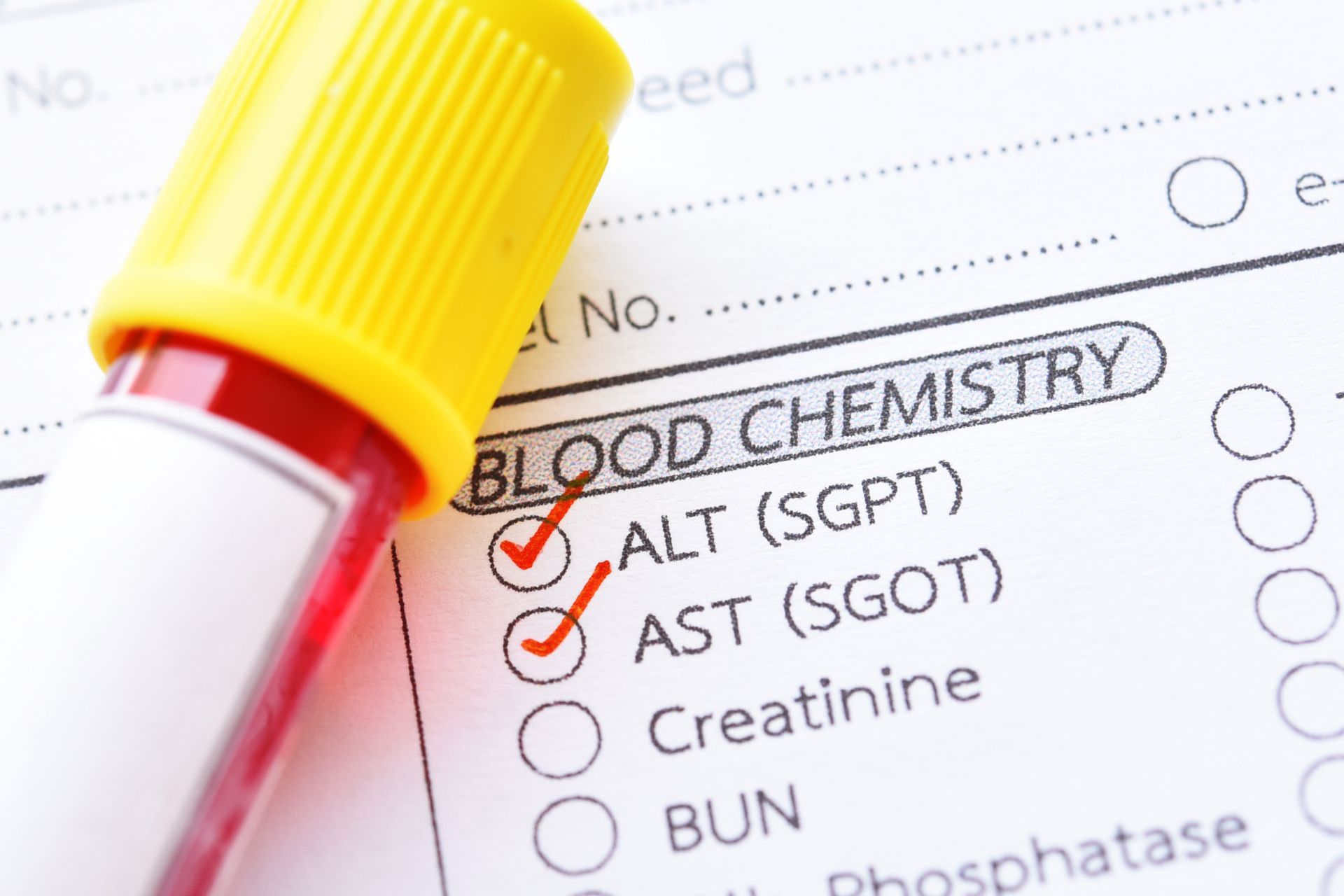
Normal Ranges for AST and ALT
Determining the normal range for AST and ALT can be complex due to various factors influencing these values. Generally, the normal range for aminotransferase levels is slightly higher in males, non-whites, and obese individuals.
Factors affecting normal AST and ALT ranges:
- Gender
- Ethnicity
- Body mass index (BMI)
- Age
- Overall health status
Is there a universal normal range for AST and ALT? While specific ranges may vary between laboratories, generally, normal ALT levels are considered to be below 50 U/L for men and 35 U/L for women. AST levels are typically considered normal when below 40 U/L for both genders.
High AST and ALT Levels: Causes and Implications
Elevated AST and ALT levels often indicate liver damage or disease. However, the extent of elevation and the ratio between AST and ALT can provide valuable insights into the underlying cause.
Common causes of high AST and ALT:
- Acute hepatitis (viral, toxic, or ischemic)
- Chronic liver diseases (e.g., hepatitis C, cirrhosis)
- Alcoholic liver disease
- Non-alcoholic fatty liver disease (NAFLD)
- Drug-induced liver injury
- Autoimmune hepatitis
How high can AST and ALT levels go in liver diseases? In acute hepatitis, AST and ALT levels can rise dramatically, often exceeding 1000 U/L. However, in chronic liver diseases, the elevation may be more modest, sometimes less than 1.5 times the upper limit of normal.
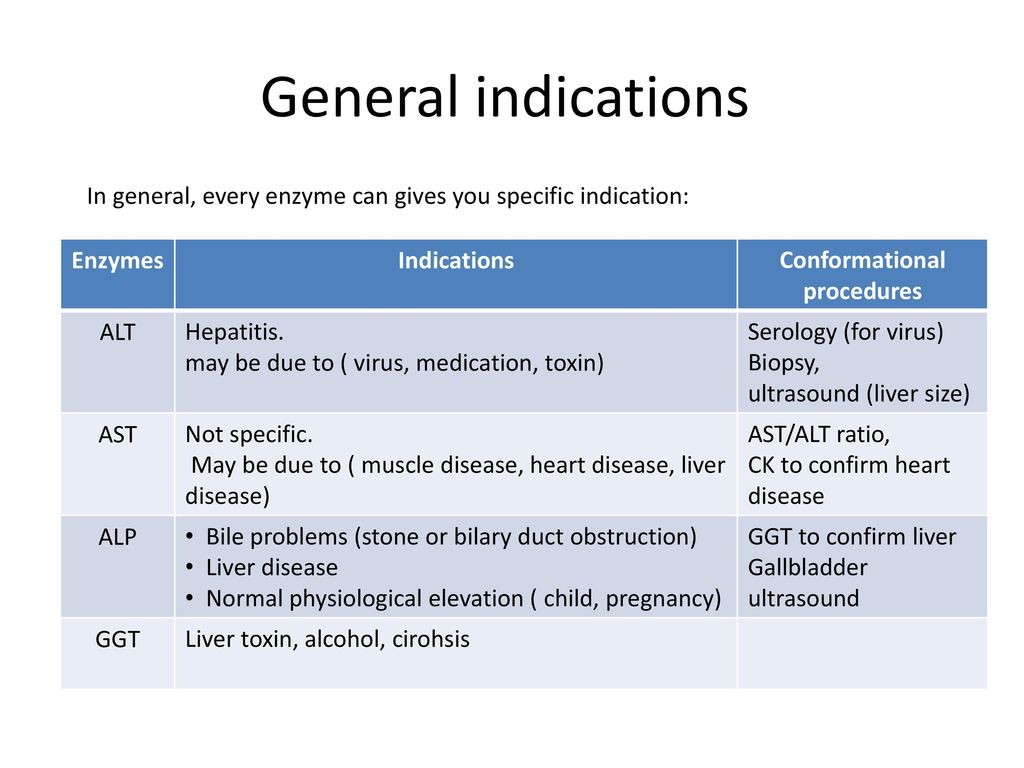
Low AST and ALT Levels: What Do They Mean?
While high AST and ALT levels often grab attention, low levels can also be significant. Low AST and ALT levels are less common and may indicate different health concerns.
Potential causes of low AST and ALT:
- Vitamin B6 deficiency
- Severe kidney disease
- Some medications
- Pregnancy (in later stages)
Are low AST and ALT levels always concerning? Not necessarily. In some cases, low levels may simply reflect individual variation or a healthy liver. However, persistently low levels, especially when accompanied by other symptoms, warrant further investigation.
Symptoms Associated with Abnormal AST and ALT Levels
Abnormal AST and ALT levels don’t always produce noticeable symptoms, particularly in early stages of liver disease. However, as liver damage progresses, various symptoms may emerge.
Symptoms potentially related to high AST and ALT:
- Fatigue
- Abdominal pain or discomfort
- Jaundice (yellowing of skin and eyes)
- Nausea and loss of appetite
- Dark urine
- Pale stools
Can abnormal AST and ALT levels cause symptoms directly? Not typically. The symptoms are usually a result of the underlying liver condition causing the abnormal enzyme levels, rather than the elevated enzymes themselves.

Special Considerations in Interpreting AST and ALT Results
Interpreting AST and ALT results requires careful consideration of various factors and potential pitfalls. Some special situations can complicate the interpretation of these liver function tests.
Key considerations:
- AST/ALT ratio: An AST/ALT ratio greater than 2 often suggests alcoholic liver disease
- Mild elevations: ALT levels less than 1.5 times normal could be within the individual’s normal range
- Non-liver sources: Muscle injury or myopathy can cause elevated ALT
- Acute vs. chronic: Very high levels often indicate acute injury, while persistent mild elevations may suggest chronic disease
Why is the AST/ALT ratio important? The AST/ALT ratio can provide clues about the nature of liver damage. In alcoholic liver disease, AST tends to be higher than ALT, often with a ratio exceeding 2:1. Conversely, in viral hepatitis and many other liver diseases, ALT is typically higher than AST.
Differential Diagnosis of Abnormal AST and ALT
When faced with abnormal AST and ALT results, healthcare providers must consider a wide range of potential causes. The differential diagnosis depends on the pattern of elevation, associated symptoms, and patient history.
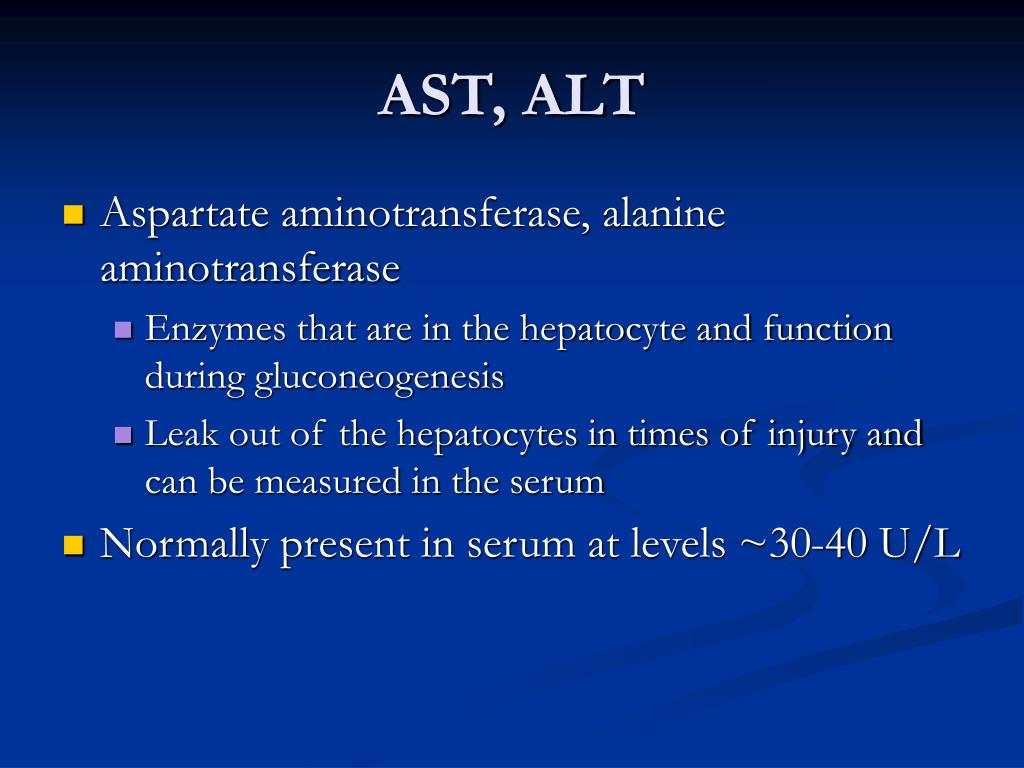
Common scenarios and their potential causes:
- Acute severe elevation (>10 times upper limit of normal):
- Acute viral hepatitis
- Drug-induced liver injury
- Ischemic hepatitis
- Mild chronic elevation (1-3 times upper limit of normal):
- Chronic viral hepatitis
- Non-alcoholic fatty liver disease
- Alcoholic liver disease
- Autoimmune hepatitis
- Isolated AST elevation:
- Muscle disorders
- Cardiac conditions
- Hemolysis
How can clinicians differentiate between these causes? A thorough history, physical examination, and additional tests are often necessary. For example, testing for viral hepatitis markers, assessing alcohol consumption, and evaluating for metabolic syndrome can help narrow down the diagnosis.
Management and Monitoring of Abnormal AST and ALT Levels
The management of abnormal AST and ALT levels depends on the underlying cause and the extent of liver damage. Regular monitoring is crucial for assessing disease progression and treatment effectiveness.
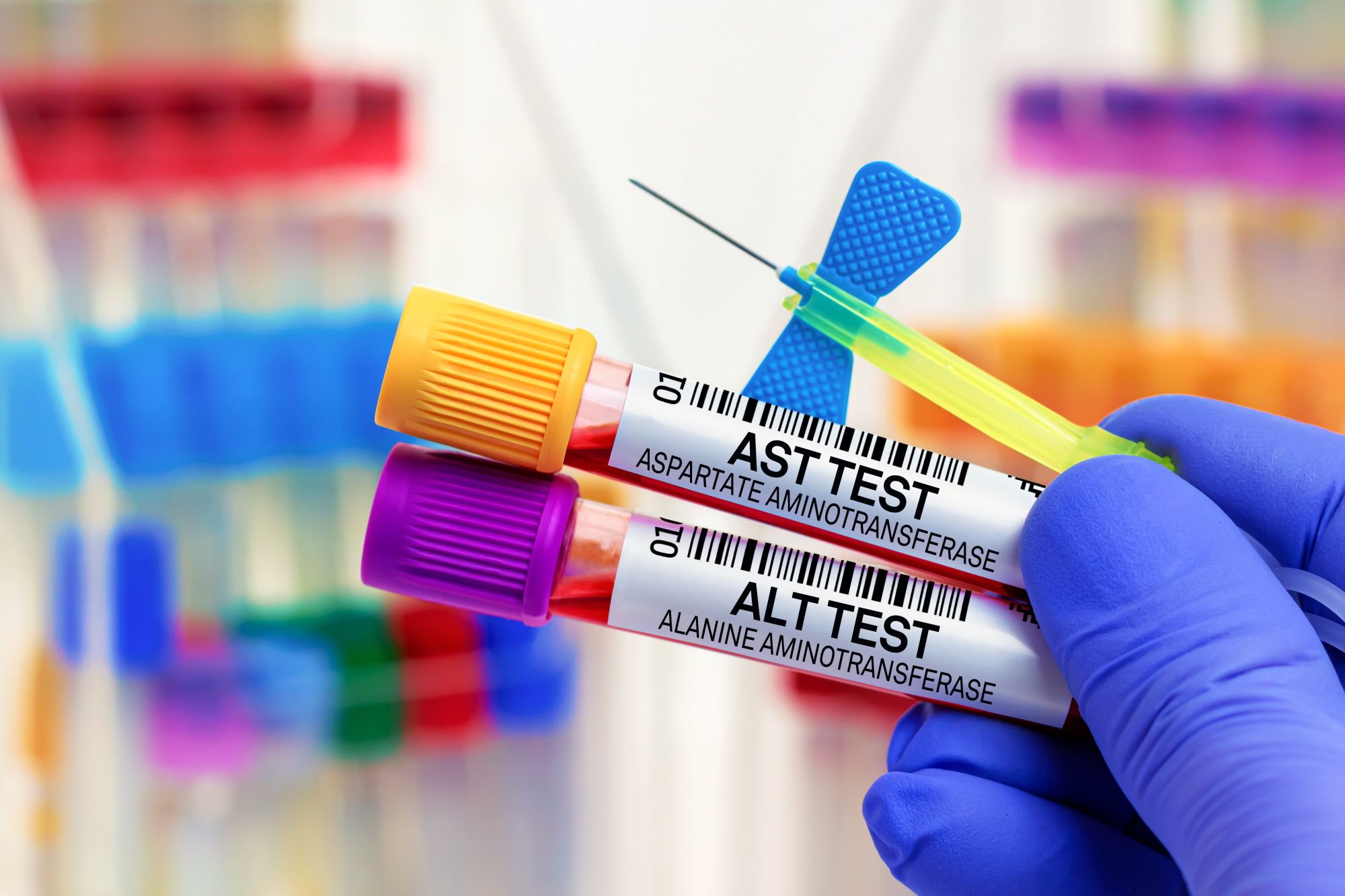
General management principles:
- Identify and address the underlying cause
- Lifestyle modifications (e.g., alcohol cessation, weight loss)
- Treat specific liver diseases (e.g., antiviral therapy for hepatitis B or C)
- Monitor liver function regularly
- Consider liver protective agents in some cases
How often should AST and ALT levels be monitored? The frequency of monitoring depends on the specific condition and treatment plan. In acute conditions, levels may be checked daily or weekly. For chronic diseases, monthly or quarterly monitoring may be sufficient once the condition is stable.
Monitoring considerations:
- Trend is often more important than absolute values
- Consider other liver function tests (e.g., bilirubin, albumin, prothrombin time)
- Assess for development of complications (e.g., cirrhosis, portal hypertension)
When should additional imaging or liver biopsy be considered? Persistent unexplained elevations, signs of advanced liver disease, or suspicion of hepatocellular carcinoma may warrant further imaging studies or liver biopsy.

Future Directions in AST and ALT Research
As our understanding of liver physiology and pathology evolves, so does the interpretation and utilization of AST and ALT tests. Ongoing research aims to improve the diagnostic accuracy and prognostic value of these markers.
Emerging areas of research:
- Novel biomarkers for liver injury and fibrosis
- Non-invasive assessment of liver fibrosis (e.g., elastography)
- Genetic factors influencing AST and ALT levels
- Role of AST and ALT in metabolic diseases
How might future developments change AST and ALT testing? Advanced molecular techniques and imaging modalities may complement traditional AST and ALT tests, providing more precise information about liver health and disease progression. Personalized reference ranges based on genetic and environmental factors could enhance the interpretation of these tests.
The landscape of liver function assessment continues to evolve, with AST and ALT remaining cornerstone tests. Their interpretation, however, requires a nuanced understanding of various factors and potential pitfalls. As research progresses, clinicians and patients alike can look forward to more accurate and personalized approaches to liver health assessment and management.

Special Considerations in Interpreting Liver Function Tests
DAVID E. JOHNSTON, M.D.
A number of pitfalls can be encountered in the interpretation of common blood liver function tests. These tests can be normal in patients with chronic hepatitis or cirrhosis. The normal range for aminotransferase levels is slightly higher in males, nonwhites and obese persons. Severe alcoholic hepatitis is sometimes confused with cholecystitis or cholangitis. Conversely, patients who present soon after passing common bile duct stones can be misdiagnosed with acute hepatitis because aminotransferase levels often rise immediately, but alkaline phosphatase and γ-glutamyltransferase levels do not become elevated for several days. Asymptomatic patients with isolated, mild elevation of either the unconjugated bilirubin or the γ-glutamyltransferase value usually do not have liver disease and generally do not require extensive evaluation. Overall hepatic function can be assessed by applying the values for albumin, bilirubin and prothrombin time in the modified Child-Turcotte grading system.
Asymptomatic patients with isolated, mild elevation of either the unconjugated bilirubin or the γ-glutamyltransferase value usually do not have liver disease and generally do not require extensive evaluation. Overall hepatic function can be assessed by applying the values for albumin, bilirubin and prothrombin time in the modified Child-Turcotte grading system.
The commonly used liver function tests (LFTs) primarily assess liver injury rather than hepatic function. Indeed, these blood tests may reflect problems arising outside the liver, such as hemolysis (elevated bilirubin level) or bone disease (elevated alkaline phosphatase [AP] level).
Abnormal LFTs often, but not always, indicate that something is wrong with the liver, and they can provide clues to the nature of the problem. However, normal LFTs do not always mean that the liver is normal. Patients with cirrhosis and bleeding esophageal varices can have normal LFTs. Of the routine LFTs, only serum albumin, bilirubin and prothrombin time (PT) provide useful information on how well the liver is functioning.
The general subject of LFTs1,2 and the differential diagnosis of abnormal LFTs in asymptomatic patients3–5 have been well reviewed. This article discusses some common pitfalls in the interpretation of LFTs. Hints for interpreting these tests are presented in Table 1.
| Situation | Comments |
|---|---|
| Mildly elevated ALT level (less than 1.5 times normal) | ALT value could be normal for gender, ethnicity or body mass index. |
| Consider muscle injury or myopathy. | |
| Alcoholic hepatitis | Laboratory values can appear cholestatic, and symptoms can mimic cholecystitis. |
| Minimal elevations of AST and ALT often occur. | |
| AST level greater than 500 U per L | The AST elevation is unlikely to result from alcohol intake alone.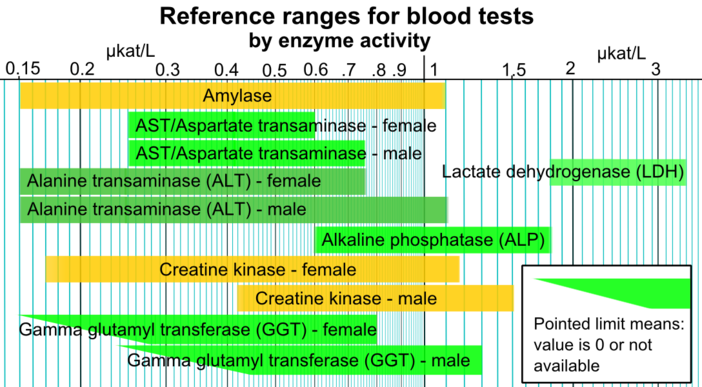 |
| In a heavy drinker, consider acetaminophen toxicity. | |
| Common bile duct stone | Condition can simulate acute hepatitis |
| AST and ALT become elevated immediately, but elevation of AP and GGT is delayed. | |
| Isolated elevation of GGT level | This situation may be induced by alcohol and aromatic medications, usually with no actual liver disease. |
| Isolated elevation of AP level (asymptomatic patient with normal GGT level) | Consider bone growth or injury, or primary biliary cirrhosis. |
| AP level rises in late pregnancy. | |
| Isolated elevation of unconjugated bilirubin level | Consider Gilbert syndrome or hemolysis. |
| Low albumin level | Low albumin is most often caused by acute or chronic inflammation, urinary loss, severe malnutrition or liver disease; it is sometimes caused by gastrointestinal loss (e.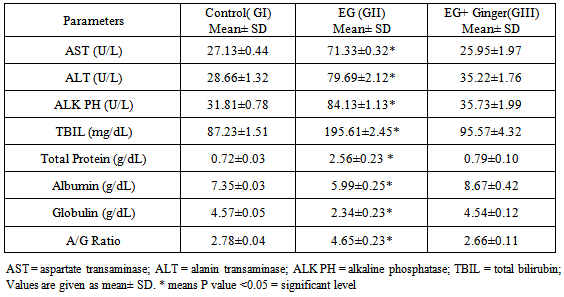 g., colitis or some uncommon small bowel disease). g., colitis or some uncommon small bowel disease). |
| Normal values are lower in pregnancy. | |
| Blood ammonia level | Blood ammonia values are not necessarily elevated in patients with hepatic encephalopathy. |
| Determination of blood ammonia levels is most useful in patients with altered mental status of new onset or unknown origin. |
Markers of Hepatocellular Injury
The most commonly used markers of hepatocyte injury are aspartate aminotransferase (AST, formerly serum glutamic-oxaloacetic transaminase [SGOT]) and alanine aminotransferase (ALT, formerly serum glutamate-pyruvate transaminase [SGPT]). While ALT is cytosolic, AST has both cytosolic and mitochondrial forms.
Hepatocyte necrosis in acute hepatitis, toxic injury or ischemic injury results in the leakage of enzymes into the circulation. However, in chronic liver diseases such as hepatitis C and cirrhosis, the serum ALT level correlates only moderately well with liver inflammation. In hepatitis C, liver cell death occurs by apoptosis (programmed cell death) as well as by necrosis. Hepatocytes dying by apoptosis presumably synthesize less AST and ALT as they wither away. This probably explains why at least one third of patients infected with hepatitis C virus have persistently normal serum ALT levels despite the presence of inflammation on liver biopsy.6,7 Patients with cirrhosis often have normal or only slightly elevated serum AST and ALT levels. Thus, AST and ALT lack some sensitivity in detecting chronic liver injury. Of course, AST and ALT levels tend to be higher in cirrhotic patients with continuing inflammation or necrosis than in those without continuing liver injury.
In hepatitis C, liver cell death occurs by apoptosis (programmed cell death) as well as by necrosis. Hepatocytes dying by apoptosis presumably synthesize less AST and ALT as they wither away. This probably explains why at least one third of patients infected with hepatitis C virus have persistently normal serum ALT levels despite the presence of inflammation on liver biopsy.6,7 Patients with cirrhosis often have normal or only slightly elevated serum AST and ALT levels. Thus, AST and ALT lack some sensitivity in detecting chronic liver injury. Of course, AST and ALT levels tend to be higher in cirrhotic patients with continuing inflammation or necrosis than in those without continuing liver injury.
As markers of hepatocellular injury, AST and ALT also lack some specificity because they are found in skeletal muscle. Levels of these aminotransferases can rise to several times normal after severe muscular exertion or other muscle injury, as in polymyositis,8 or in the presence of hypothyroidism, which can cause mild muscle injury and the release of aminotransferases. In fact, AST and ALT were once used in the diagnosis of myocardial infarction.
In fact, AST and ALT were once used in the diagnosis of myocardial infarction.
Slight AST or ALT elevations (within 1.5 times the upper limits of normal) do not necessarily indicate liver disease. Part of this ambiguity has to do with the fact that unlike the values in many other biochemical tests, serum AST and ALT levels do not follow a normal bell-shaped distribution in the population.9 Instead, AST and ALT values have a skewed distribution characterized by a long “tail” at the high end of the scale (Figure 1).5 For example, the mean values for ALT are very similar from one population to another, but the degree to which the distribution is skewed varies by gender and ethnicity. The ALT distributions in males and nonwhites (i.e., blacks and Hispanics) tend to have a larger tail at the high end, so that more values fall above the upper limits of normal set for the average population.10,11
AST and ALT values are higher in obese patients, probably because these persons commonly have fatty livers. 12 ALT levels have been noted to decline with weight loss.13 Depending on the physician’s point of view, the upper limits of normal for AST and ALT levels could be set higher for more obese persons.
12 ALT levels have been noted to decline with weight loss.13 Depending on the physician’s point of view, the upper limits of normal for AST and ALT levels could be set higher for more obese persons.
Rare individuals have chronically elevated AST levels because of a defect in clearance of the enzyme from the circulation.14 For both AST and ALT, the average values and upper limits of normal in patients undergoing renal dialysis are about one half of those found in the general population.15 Mild elevations of ALT or AST in asymptomatic patients can be evaluated efficiently by considering alcohol abuse, hepatitis B, hepatitis C and several other possible diagnoses (Table 2).5
The rightsholder did not grant rights to reproduce this item in electronic media. For the missing item, see the original print version of this publication.
Various liver diseases are associated with typical ranges of AST and ALT levels (Figure 2).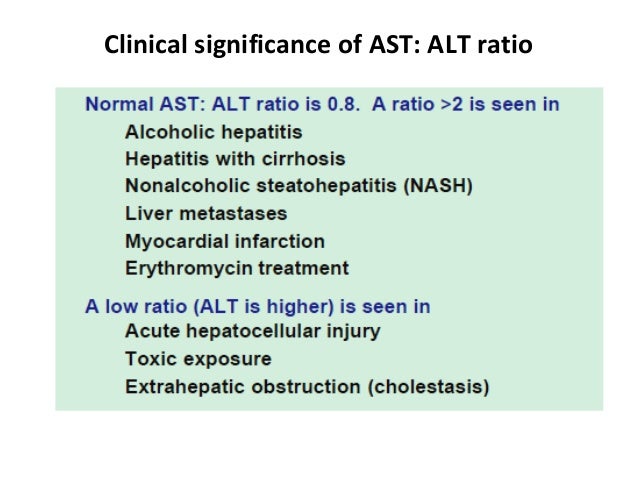 ALT levels often rise to several thousand units per liter in patients with acute viral hepatitis. The highest ALT levels—often more than 10,000 U per L—are usually found in patients with acute toxic injury subsequent to, for example, acetaminophen overdose or acute ischemic insult to the liver. AST and ALT levels usually fall rapidly after an acute insult.
ALT levels often rise to several thousand units per liter in patients with acute viral hepatitis. The highest ALT levels—often more than 10,000 U per L—are usually found in patients with acute toxic injury subsequent to, for example, acetaminophen overdose or acute ischemic insult to the liver. AST and ALT levels usually fall rapidly after an acute insult.
Lactate dehydrogenase (LDH) is less specific than AST and ALT as a marker of hepatocyte injury. However, it is worth noting that LDH is disproportionately elevated after an ischemic liver injury.16
It is especially important to remember that in patients with acute alcoholic hepatitis, the serum AST level is almost never greater than 500 U per L and the serum ALT value is almost never greater than 300 U per L. The reasons for these limits on AST and ALT elevations are not well understood. In typical viral or toxic liver injury, the serum ALT level rises more than the AST value, reflecting the relative amounts of these enzymes in hepatocytes. However, in alcoholic hepatitis, the ratio of AST to ALT is greater than 1 in 90 percent of patients and is usually greater than 2.17 The higher the AST-to-ALT ratio, the greater the likelihood that alcohol is contributing to the abnormal LFTs. In the absence of alcohol intake, an increased AST-to-ALT ratio is often found in patients with cirrhosis.
However, in alcoholic hepatitis, the ratio of AST to ALT is greater than 1 in 90 percent of patients and is usually greater than 2.17 The higher the AST-to-ALT ratio, the greater the likelihood that alcohol is contributing to the abnormal LFTs. In the absence of alcohol intake, an increased AST-to-ALT ratio is often found in patients with cirrhosis.
The elevated AST-to-ALT ratio in alcoholic liver disease results in part from the depletion of vitamin B6 (pyridoxine) in chronic alcoholics.18 ALT and AST both use pyridoxine as a coenzyme, but the synthesis of ALT is more strongly inhibited by pyridoxine deficiency than is the synthesis of AST. Alcohol also causes mitochondrial injury, which releases the mitochondrial isoenzyme of AST.
Patients with alcoholic hepatitis can present with jaundice, abdominal pain, fever and a minimally elevated AST value, thereby leading to a misdiagnosis of cholecystitis. This is a potentially fatal mistake given the high surgical mortality rate in patients with alcoholic hepatitis. 19
19
Markers of Cholestasis
Cholestasis (lack of bile flow) results from the blockage of bile ducts or from a disease that impairs bile formation in the liver itself. AP and γ-glutamyltransferase (GGT) levels typically rise to several times the normal level after several days of bile duct obstruction or intrahepatic cholestasis. The highest liver AP elevations—often greater than 1,000 U per L, or more than six times the normal value—are found in diffuse infiltrative diseases of the liver such as infiltrating tumors and fungal infections.
Diagnostic confusion can occur when a patient presents within a few hours after acute bile duct obstruction from a gallstone. In this situation, AST and ALT levels often reach 500 U per L or more in the first hours and then decline, whereas AP and GGT levels can take several days to rise.
Both AP and GGT levels are elevated in about 90 percent of patients with cholestasis.20 The elevation of GGT alone, with no other LFT abnormalities, often results from enzyme induction by alcohol or aromatic medications in the absence of liver disease. The GGT level is often elevated in persons who take three or more alcoholic drinks (45 g of ethanol or more) per day.21 Thus, GGT is a useful marker for immoderate alcohol intake. Phenobarbital, phenytoin (Dilantin) and other aromatic drugs typically cause GGT elevations of about twice normal. A mildly elevated GGT level is a typical finding in patients taking anticonvulsants and by itself does not necessarily indicate liver disease.22,23
The GGT level is often elevated in persons who take three or more alcoholic drinks (45 g of ethanol or more) per day.21 Thus, GGT is a useful marker for immoderate alcohol intake. Phenobarbital, phenytoin (Dilantin) and other aromatic drugs typically cause GGT elevations of about twice normal. A mildly elevated GGT level is a typical finding in patients taking anticonvulsants and by itself does not necessarily indicate liver disease.22,23
Serum AP originates mostly from liver and bone, which produce slightly different forms of the enzyme. The serum AP level rises during the third trimester of pregnancy because of a form of the enzyme produced in the placenta. When serum AP originates from bone, clues to bone disease are often present, such as recent fracture, bone pain or Paget’s disease of the bone (often found in the elderly). Like the GGT value, the AP level can become mildly elevated in patients who are taking phenytoin.22,23
If the origin of an elevated serum AP level is in doubt, the isoenzymes of AP can be separated by electrophoresis.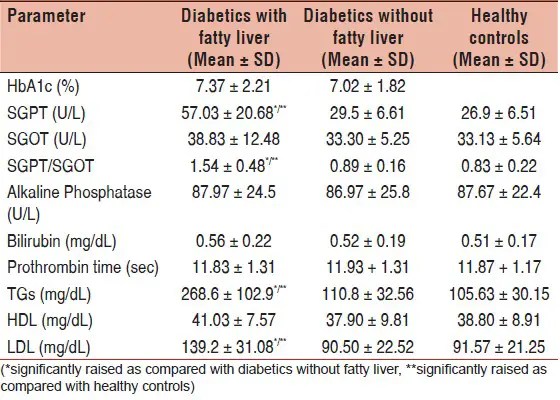 However, this process is expensive and usually unnecessary because an elevated liver AP value is usually accompanied by an elevated GGT level, an elevated 5′-nucleotidase level and other LFT abnormalities.
However, this process is expensive and usually unnecessary because an elevated liver AP value is usually accompanied by an elevated GGT level, an elevated 5′-nucleotidase level and other LFT abnormalities.
In one study,24 isolated AP elevations were evaluated in an unselected group of patients at a Veterans Affairs hospital. Most mild AP elevations (less than 1.5 times normal) resolved within six months, and almost all greater elevations had an evident cause that was found on routine clinical evaluation.
Persistently elevated liver AP values in asymptomatic patients, especially women, can be caused by primary biliary cirrhosis, which is a chronic inflammatory disorder of the small bile ducts. Serum antimitochondrial antibody is positive in almost all of these patients.
Indicators of How Well the Liver Functions
BILIRUBIN
Bilirubin results from the enzymatic breakdown of heme. Unconjugated bilirubin is conjugated with glucuronic acid in hepatocytes to increase its water solubility and is then rapidly transported into bile. The serum conjugated bilirubin level does not become elevated until the liver has lost at least one half of its excretory capacity. Thus, a patient could have obstruction of either the left or right hepatic duct without a rise in the bilirubin level.
The serum conjugated bilirubin level does not become elevated until the liver has lost at least one half of its excretory capacity. Thus, a patient could have obstruction of either the left or right hepatic duct without a rise in the bilirubin level.
Because the secretion of conjugated bilirubin into bile is very rapid in comparison with the conjugation step, healthy persons have almost no detectable conjugated bilirubin in their blood. Liver disease mainly impairs the secretion of conjugated bilirubin into bile. As a result, conjugated bilirubin is rapidly filtered into the urine, where it can be detected by a dipstick test. The finding of bilirubin in urine is a particularly sensitive indicator of the presence of an increased serum conjugated bilirubin level.
In many healthy persons, the serum unconjugated bilirubin is mildly elevated to a concentration of 2 to 3 mg per dL (34 to 51 μmol per L) or slightly higher, especially after a 24-hour fast. If this is the only LFT abnormality and the conjugated bilirubin level and complete blood count are normal, the diagnosis is usually assumed to be Gilbert syndrome, and no further evaluation is required. Gilbert syndrome was recently shown to be related to a variety of partial defects in uridine diphosphate-glucuronosyl transferase, the enzyme that conjugates bilirubin.25
Gilbert syndrome was recently shown to be related to a variety of partial defects in uridine diphosphate-glucuronosyl transferase, the enzyme that conjugates bilirubin.25
Mild hemolysis, such as that caused by hereditary spherocytosis and other disorders, can also result in elevated unconjugated bilirubin values, but hemolysis is not usually present if the hematocrit and blood smear are normal. The presence of hemolysis can be confirmed by testing other markers, such as haptoglobin, or by measuring the reticulocyte count.
Severe defects in bilirubin transport and conjugation can lead to markedly elevated unconjugated bilirubin levels, which can cause serious neurologic damage (kernicterus) in infants. However, no serious form of liver disease in adults causes elevation of unconjugated bilirubin levels in the blood without also causing elevation of conjugated bilirubin values.
When a patient has prolonged, severe biliary obstruction followed by the restoration of bile flow, the serum bilirubin level often declines rapidly for several days and then slowly returns to normal over a period of weeks.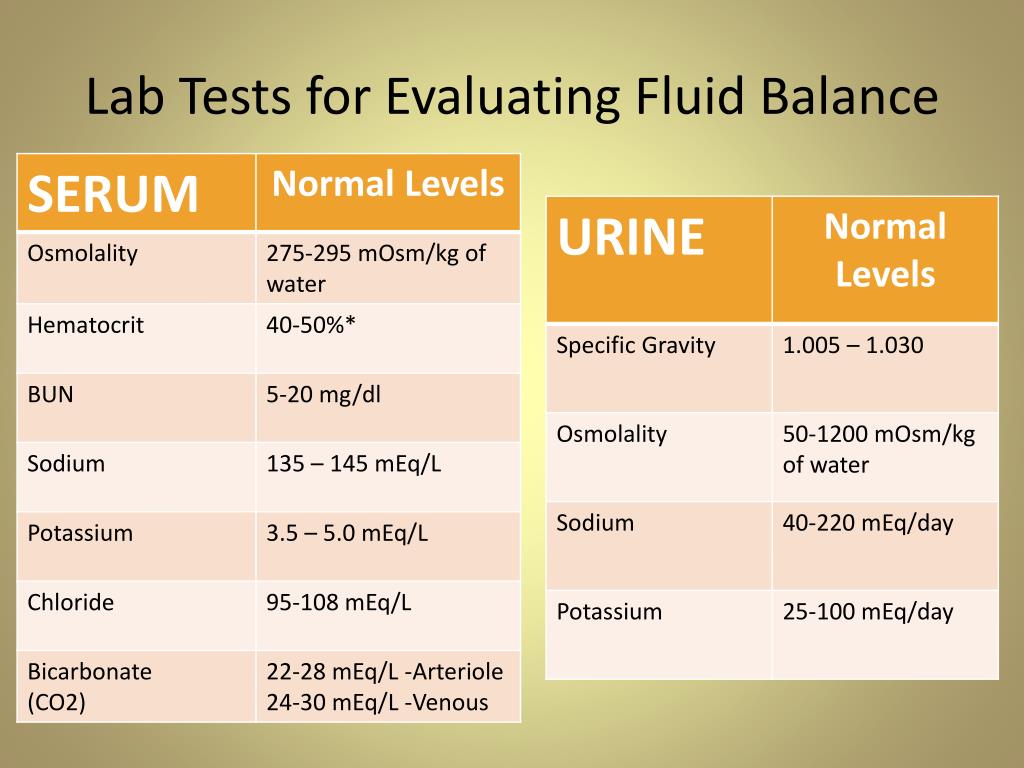 The slow phase of bilirubin clearance results from the presence of delta-bilirubin, a form of bilirubin chemically attached to serum albumin.26 Because albumin has a half-life of three weeks, delta-bilirubin clears much more slowly than bilirubin-glucuronide. Clinical laboratories can measure delta-bilirubin concentrations, but such measurements are usually unnecessary if the physician is aware of the delta-bilirubin phenomenon.
The slow phase of bilirubin clearance results from the presence of delta-bilirubin, a form of bilirubin chemically attached to serum albumin.26 Because albumin has a half-life of three weeks, delta-bilirubin clears much more slowly than bilirubin-glucuronide. Clinical laboratories can measure delta-bilirubin concentrations, but such measurements are usually unnecessary if the physician is aware of the delta-bilirubin phenomenon.
ALBUMIN
Although the serum albumin level can serve as an index of liver synthetic capacity, several factors make albumin concentrations difficult to interpret.27 The liver can synthesize albumin at twice the healthy basal rate and thus partially compensate for decreased synthetic capacity or increased albumin losses. Albumin has a plasma half-life of three weeks; therefore, serum albumin concentrations change slowly in response to alterations in synthesis. Furthermore, because two thirds of the amount of body albumin is located in the extravascular, extracellular space, changes in distribution can alter the serum concentration.
In practice, patients with low serum albumin concentrations and no other LFT abnormalities are likely to have a nonhepatic cause for low albumin, such as proteinuria or an acute or chronic inflammatory state. Albumin synthesis is immediately and severely depressed in inflammatory states such as burns, trauma and sepsis, and it is commonly depressed in patients with active rheumatic disorders or severe end-stage malnutrition. In addition, normal albumin values are lower in pregnancy.
PROTHROMBIN TIME
The liver synthesizes blood clotting factors II, V, VII, IX and X. The prothrombin time (PT) does not become abnormal until more than 80 percent of liver synthetic capacity is lost. This makes PT a relatively insensitive marker of liver dysfunction. However, abnormal PT prolongation may be a sign of serious liver dysfunction. Because factor VII has a short half-life of only about six hours, it is sensitive to rapid changes in liver synthetic function. Thus, PT is very useful for following liver function in patients with acute liver failure.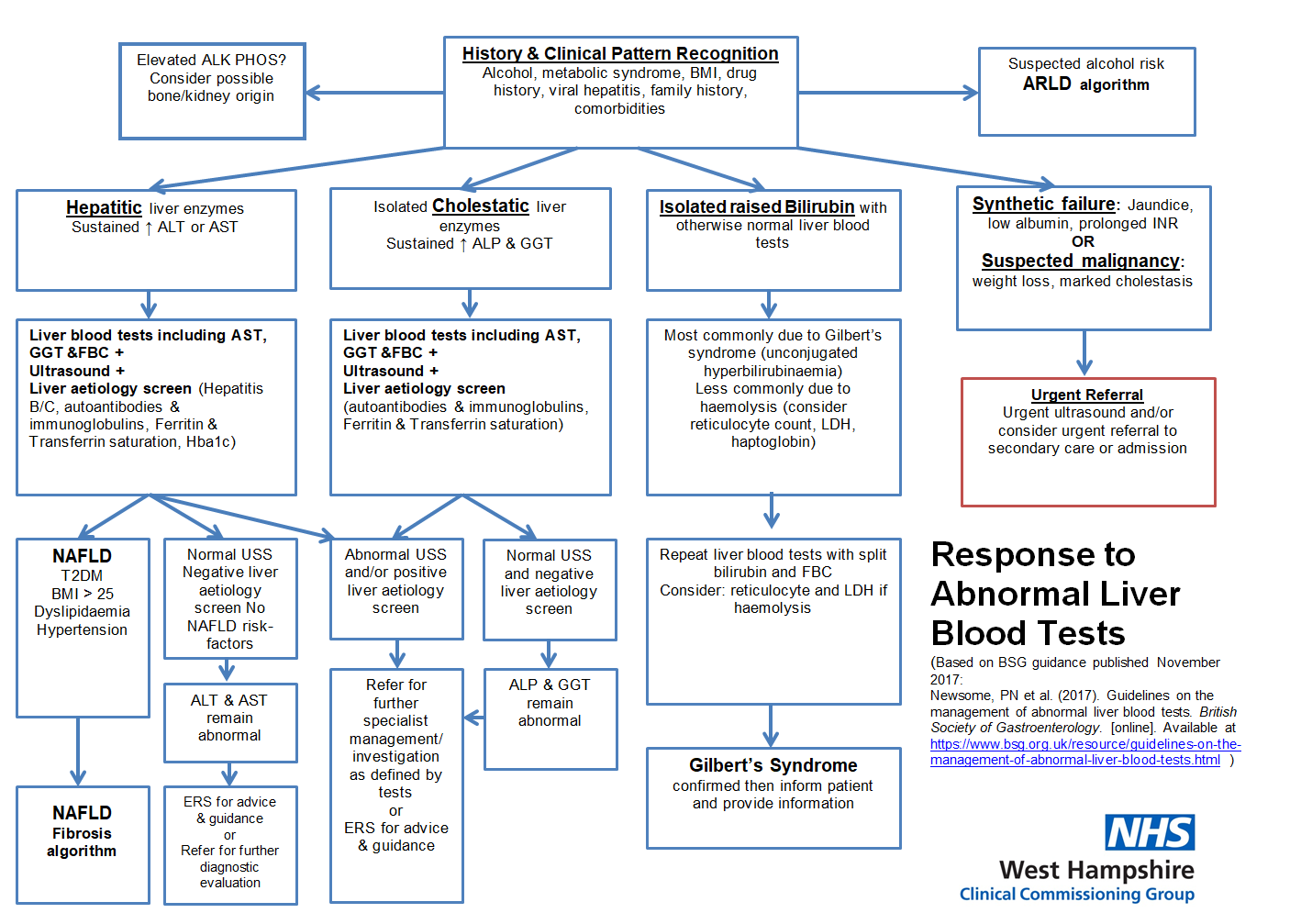
An elevated PT can result from a vitamin K deficiency. This deficiency usually occurs in patients with chronic cholestasis or fat malabsorption from disease of the pancreas or small bowel. A trial of vitamin K injections (e.g., 5 mg per day administered subcutaneously for three days) is the most practical way to exclude vitamin K deficiency in such patients. The PT should improve within a few days.
BLOOD AMMONIA
Measurement of the blood ammonia concentration is not always useful in patients with known or suspected hepatic encephalopathy. Ammonia contributes to hepatic encephalopathy; however, ammonia concentrations are much higher in the brain than in the blood and therefore do not correlate well.28 Furthermore, ammonia is not the only waste product responsible for encephalopathy. Thus, blood ammonia concentrations show only a mediocre correlation with the level of mental status in patients with liver disease. It is not unusual for the blood ammonia concentration to be normal in a patient who is in a coma from hepatic encephalopathy.
Blood ammonia levels are best measured in arterial blood because venous concentrations can be elevated as a result of muscle metabolism of amino acids. Blood ammonia concentrations are most useful in evaluating patients with stupor or coma of unknown origin. It is not necessary to evaluate blood ammonia levels routinely in patients with known chronic liver disease who are responding to therapy as expected.
Grading Liver Function by Child-Turcotte Class
In communicating among themselves, many physicians use the Child-Turcotte class as modified by Pugh, often termed the “Child class,” to convey information about overall liver function and prognosis (Table 3).29 This grading system can be used to predict overall life expectancy and surgical mortality in patients with cirrhosis and other liver diseases.30
The rightsholder did not grant rights to reproduce this item in electronic media. For the missing item, see the original print version of this publication.
For elective general abdominal surgery, perioperative mortality is in the neighborhood of several percent for patients who fall into the Child class A, 10 to 20 percent for those in class B and approximately 50 percent for those in class C.31 These percentages must be balanced by prognostic considerations when transplantation becomes an option. The presence of cirrhosis by itself is not an indication for liver transplantation, and transplantation is rarely performed in patients who fall into Child class A. For example, the 10-year survival rate is as high as 80 percent in patients with hepatitis C and cirrhosis who have Child class A liver function and no variceal bleeding.32 However, once patients with any type of liver disease fall into the Child-Turcotte class B or class C category, survival is significantly reduced and transplantation should be considered.
Mildly Elevated Liver Transaminase Levels in the Asymptomatic Patient
PAUL T. GIBONEY, M.D.
GIBONEY, M.D.
Mild elevations in liver chemistry tests such as alanine transaminase and aspartate transaminase can reveal serious underlying conditions or have transient and benign etiologies. Potential causes of liver transaminase elevations include viral hepatitis, alcohol use, medication use, steatosis or steatohepatitis, and cirrhosis. The history should be thorough, with special attention given to the use of medications, vitamins, herbs, drugs, and alcohol; family history; and any history of blood-product transfusions. Other common health conditions, such as diabetes, heart disease, and thyroid disease, can cause or augment liver transaminase elevations. The recent American Gastroenterological Association guideline regarding the evaluation and management of abnormal liver chemistry tests proposes a practical, algorithmic approach when the history and physical examination do not reveal the cause. In addition to liver chemistries, an initial serologic evaluation includes a prothrombin time; albumin; complete blood count with platelets; hepatitis A, B, and C serologies; and iron studies. Depending on the etiology, management strategies may include cessation of alcohol use, attention to medications, control of diabetes, and modification of lifestyle factors such as obesity. If elevations persist after an appropriate period of observation, further testing may include ultra-sonography and other serum studies. In some cases, biopsy may be indicated.
In addition to liver chemistries, an initial serologic evaluation includes a prothrombin time; albumin; complete blood count with platelets; hepatitis A, B, and C serologies; and iron studies. Depending on the etiology, management strategies may include cessation of alcohol use, attention to medications, control of diabetes, and modification of lifestyle factors such as obesity. If elevations persist after an appropriate period of observation, further testing may include ultra-sonography and other serum studies. In some cases, biopsy may be indicated.
Hepatic transaminase tests such as alanine transaminase (ALT) and aspartate transaminase (AST) often are part of standard laboratory panels in asymptomatic outpatients, similar to screening tests for blood donors and for life insurance applicants. The evaluation of an abnormal ALT or AST level in an asymptomatic patient therefore is a common challenge encountered by primary care physicians.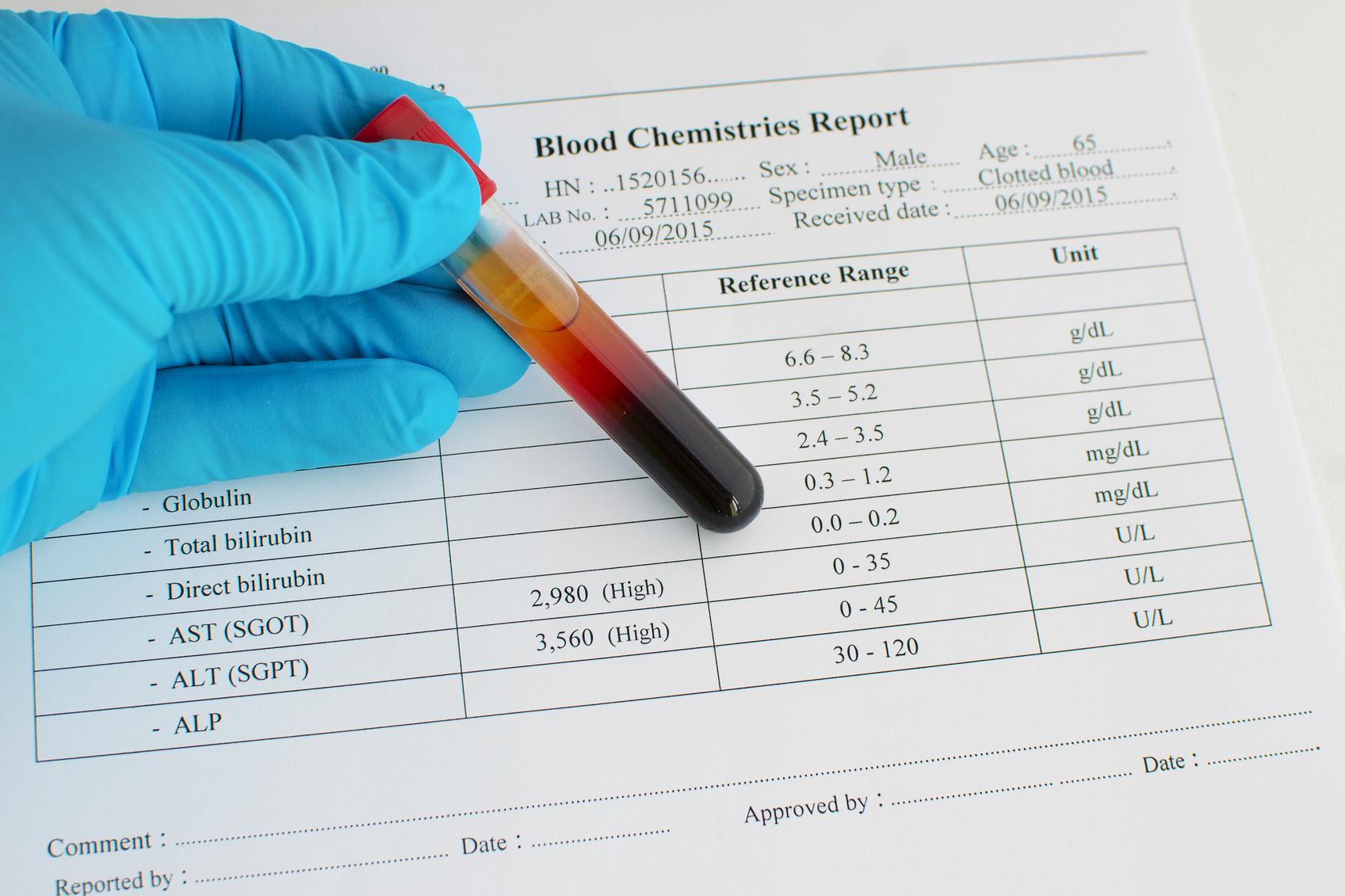
According to the American Gastroenterological Association (AGA), 1 to 4 percent of the asymptomatic population may have elevated serum liver chemistries.1 This is consistent with the usual definition of an elevated transaminase level of the top 2.5 percent of the population range. Although one study2 of 19,877 asymptomatic young Air Force trainees found that only 0.5 percent had elevated ALT levels, physicians who have more patients with obesity, diabetes, and hyperlipidemia will have to address this issue more often.
Given the frequency of this problem, physicians should develop an informed approach to the investigation of transaminase elevations. An audit of primary care practices found that these abnormalities are not always investigated appropriately and that opportunities to intervene in treatable cases sometimes are missed.3 No controlled clinical trials have compared approaches to the management of abnormal transaminase levels. However, the AGA recently published a technical review1 and a position statement4 on the evaluation of liver chemistry tests. This article reviews the interpretation of ALT and AST levels and summarizes the AGA recommendations on addressing reported elevations.
This article reviews the interpretation of ALT and AST levels and summarizes the AGA recommendations on addressing reported elevations.
| Key clinical recommendation | Label | References |
|---|---|---|
| An algorithmic approach to evaluating mildly abnormal liver functions is recommended. | C | 1 |
| In the asymptomatic patient with negative serum testing and mild transaminase elevations, a period of lifestyle modification can be tried. | C | 1 |
| If abnormalities persist at the six-month follow-up visit, an ultrasonography of the liver is the recommended imaging modality. | C | 1 |
ALT and AST are not useful screening tests in an otherwise healthy population. | C | 1,10 |
| The AST/ALT ratio is only somewhat helpful in diagnosis. | C | 5,7 |
Markers of Hepatic Injury and Necrosis
ALT and AST are two of the most reliable markers of hepatocellular injury or necrosis. Their levels can be elevated in a variety of hepatic disorders. Of the two, ALT is thought to be more specific for hepatic injury because it is present mainly in the cytosol of the liver and in low concentrations elsewhere. AST has cytosolic and mitochondrial forms and is present in tissues of the liver, heart, skeletal muscle, kidneys, brain, pancreas, and lungs, and in white and red blood cells. AST is less commonly referred to as serum glutamic oxaloacetic transaminase and ALT as serum glutamic pyruvic transaminase.
Although levels of ALT and AST can be extremely elevated (exceeding 2,000 U per L in cases of hepatocyte injury and necrosis related to drugs, toxins, ischemia, and hepatitis), elevations less than five times the upper limit of normal (i. e., about 250 U per L and below) are much more common in primary care medicine. The range of possible etiologies at this level of transaminase elevation is broader (Table 15,6) and the tests less specific. It also is important to recall that patients with normal ALT and AST levels can have significant liver disease in the setting of chronic hepatocyte injury (e.g., cirrhosis, hepatitis C).
e., about 250 U per L and below) are much more common in primary care medicine. The range of possible etiologies at this level of transaminase elevation is broader (Table 15,6) and the tests less specific. It also is important to recall that patients with normal ALT and AST levels can have significant liver disease in the setting of chronic hepatocyte injury (e.g., cirrhosis, hepatitis C).
The rightsholder did not grant rights to reproduce this item in electronic media. For the missing item, see the original print version of this publication.
The ratio of AST to ALT has some clinical utility, but has important limitations. In many forms of acute and chronic liver injury or steatosis (fatty infiltration of the liver), the ratio is less than or equal to 1. This is particularly true in patients with hepatitis C. However, an AST/ALT ratio greater than 2 characteristically is present in alcoholic hepatitis. A recent study7 of 140 patients with nonalcoholic steatohepatitis (NASH; confirmed by liver biopsy) or alcoholic liver disease found a mean AST/ALT ratio of 0. 9 in patients with NASH and 2.6 in patients with alcoholic liver disease. Within the population studied, 87 percent of patients with an AST/ALT ratio of 1.3 or less had NASH (87 percent sensitivity, 84 percent specificity). The severity of NASH as measured by the degree of fibrosis increased, as did the AST/ALT ratio. A mean ratio of 1.4 was found in patients with cirrhosis related to NASH. Wilson’s disease, a rare problem, can cause the AST/ALT ratio to exceed 4.5 While these ratios are suggestive of certain conditions, there is too much overlap between groups to rely on them exclusively when making a diagnosis.
9 in patients with NASH and 2.6 in patients with alcoholic liver disease. Within the population studied, 87 percent of patients with an AST/ALT ratio of 1.3 or less had NASH (87 percent sensitivity, 84 percent specificity). The severity of NASH as measured by the degree of fibrosis increased, as did the AST/ALT ratio. A mean ratio of 1.4 was found in patients with cirrhosis related to NASH. Wilson’s disease, a rare problem, can cause the AST/ALT ratio to exceed 4.5 While these ratios are suggestive of certain conditions, there is too much overlap between groups to rely on them exclusively when making a diagnosis.
Lactate dehydrogenase (LDH) is a less specific marker of hepatocellular necrosis and usually does not add diagnostic information to that obtained with ALT and AST testing. An exception to this is the transient but massive rise of LDH in cases of ischemic hepatitis and its sustained elevation that, along with elevated alkaline phosphatase levels, suggests malignant infiltration of the liver. 5
5
Elevations of ALT and AST are not exclusive to liver pathology. Hyperthyroidism has been found in several studies to increase serum levels of liver enzymes including ALT and AST.8 Genetic influences on the level of ALT also are possible. A study9 of Danish twins showed that genetic factors accounted for 33 to 66 percent of the variation in ALT, gamma glutamyl transpeptidase, LDH, and bilirubin in patients 73 to 94 years of age. The AGA technical review states that serum ALT has diurnal variation, may vary day to day, and may be affected by exercise. It also notes that serum AST may be 15 percent higher in black men than white men.1
Another cause of elevated liver transaminase levels is muscle injury. Strenuous exercise or myopathy can cause elevations (especially of AST) without causing any other symptoms. A creatine kinase or other muscle marker can be obtained to confirm or exclude such a process.
Annual screening of healthy, asymptomatic patients for liver disease using ALT and AST levels is not useful. A Japanese study10 assessed the accuracy of ALT and AST for detecting hepatitis C, excess alcohol use, and fatty liver disease in male bank employees and found the positive predictive value of the test to be low. Only 3.9 percent of the men with an abnormal ALT level had hepatitis C; 8 percent were excessive users of alcohol; and 35.7 percent had fatty liver.
A Japanese study10 assessed the accuracy of ALT and AST for detecting hepatitis C, excess alcohol use, and fatty liver disease in male bank employees and found the positive predictive value of the test to be low. Only 3.9 percent of the men with an abnormal ALT level had hepatitis C; 8 percent were excessive users of alcohol; and 35.7 percent had fatty liver.
Management
A thorough medical history and physical examination are the cornerstone of the evaluation of patients with mildly elevated liver transaminase levels.1 The history should attempt to identify risk factors for disease, with special attention directed toward family history, medications, vitamins, herbal supplements, drug use, alcohol use, abnormal liver testing, blood-product transfusions, and symptoms of liver disease. Table 26 lists selected medications and herbal supplements that may cause elevated transaminase levels. Physicians should ask patients directly about their use of illicit drugs, herbal supplements, and other alternative “supplements” because these sometimes are omitted from the patient’s initial response to questions.
| Medications | Herbal supplements/vitamins |
|---|---|
| Acetaminophen | Chaparral leaf |
| Amiodarone (Cordarone) | Ephedra |
| Amoxicillin-clavulanic acid | Gentian |
| Carbamazepine (Tegretol) | Germander |
| Fluconazole (Diflucan) | Jin bu huan |
| Glyburide (Micronase) | Kava |
| Heparin | Scutellaria (skullcap) |
| Isoniazid (INH) | Senna |
| Ketoconazole (Nizoral) | Shark cartilage |
| Labetalol (Normodyne) | Vitamin A |
| Nitrofurantoin (Furadantin) | |
| Nonsteroidal anti-inflammatory drugs | |
| Phenytoin (Dilantin) | |
| Protease inhibitors | |
| Sulfonamides | |
| Trazodone (Desyrel) |
The presence of other significant health conditions that can cause or augment liver transaminase elevations also should be noted; examples are diabetes, heart disease (including congestive heart failure), thyroid disease, muscle disease, and cancer. Physical findings and sequelae of liver dysfunction are given in Table 3.
Physical findings and sequelae of liver dysfunction are given in Table 3.
| Clinical clue | Suggested diagnosis |
|---|---|
| Longstanding alcohol abuse | Cirrhosis |
| Intravenous drug use, history of blood product transfusions, nonsterile needle exposure, AST/ALT ratio < 1.0 | Hepatitis B or C |
| Obesity, diabetes, hyperlipidemia, AST/ALT ratio < 1.0 | Steatosis/steatohepatitis |
| AST/ALT ratio > 2.0 | Alcoholic liver disease, Wilson’s disease |
| Increased iron levels | Hemochromatosis |
| Polypharmacy, illicit drug use, or certain herbal supplement use | Substance/medication-induced |
| Frequent, strenuous exercise | Exercise-induced |
| Intestinal bloating; oily, bulky stools | Celiac sprue |
| Hypergammaglobulinemia | Autoimmune hepatitis |
| Reduced ceruloplasmin levels, Kayser-Fleischer ring | Wilson’s disease |
| Depressed thyroid-stimulating hormone levels | Hyperthyroidism |
Once the history and physical examination are completed, additional testing can help discern the etiology of the transaminase elevation (Figure 1).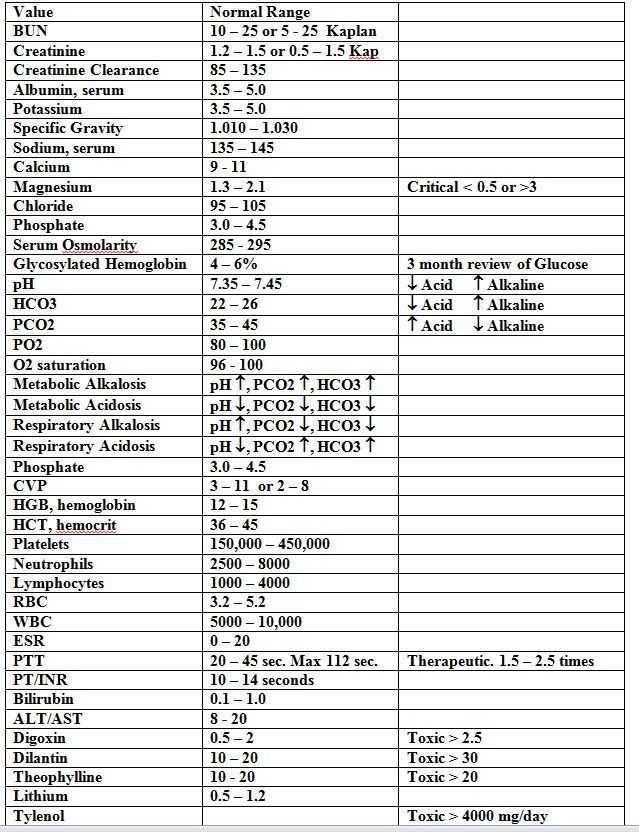 4
4
INITIAL LABORATORY EVALUATION
Additional laboratory tests should be obtained when the history and physical examination show no obvious etiology for ALT and AST elevations. Ferritin, total iron-binding capacity, and serum iron can be used to look for hemochromatosis, while hepatitis A, B, and C serologies are used to rule out acute or chronic hepatitis.
Despite the emergence of widespread vaccination, hepatitis B remains a common cause of chronic liver disease in adults. Testing for hepatitis C is essential because its incidence has increased in the past decade, and new treatment strategies have been developed that can address this frequently missed problem.11
A prothrombin time (PT) and serum albumin should be ordered to identify patients with abnormalities of protein synthesis and liver function. Evaluation should be accelerated for patients with impaired hepatic synthetic function. A complete blood count with platelets also should be ordered.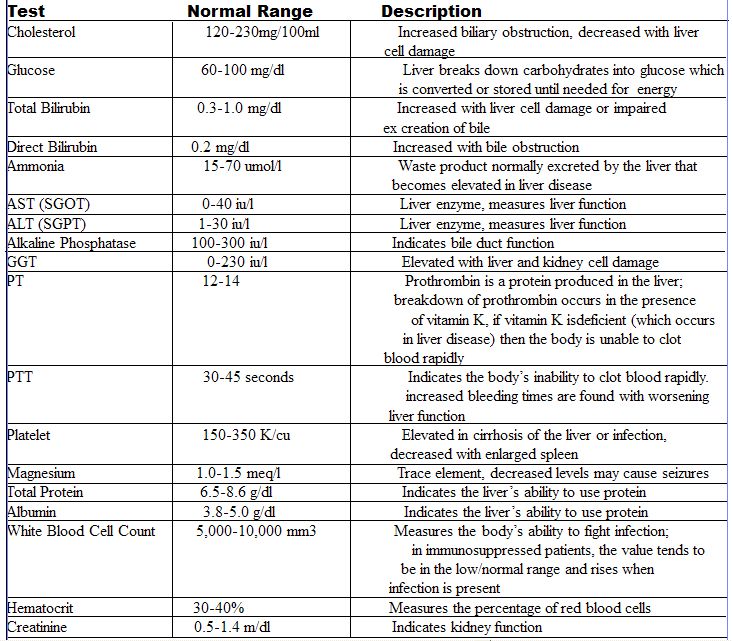 In addition to ruling out infection, neutropenia or thrombocytopenia can, along with an elevated PT, suggest advanced liver disease. An elevated mean red cell volume suggests heavy alcohol intake. Alkaline phosphatase and bilirubin are markers for hepatic cholestasis and should be ordered as part of the initial laboratory evaluation. While sometimes useful, they often are normal in the presence of hepatic injury.
In addition to ruling out infection, neutropenia or thrombocytopenia can, along with an elevated PT, suggest advanced liver disease. An elevated mean red cell volume suggests heavy alcohol intake. Alkaline phosphatase and bilirubin are markers for hepatic cholestasis and should be ordered as part of the initial laboratory evaluation. While sometimes useful, they often are normal in the presence of hepatic injury.
LIFESTYLE MODIFICATION
If the patient is asymptomatic and the initial serum testing is negative, a period of lifestyle modification can be attempted. Effective lifestyle modification includes complete abstinence from alcohol, control of diabetes and hyperlipidemia, weight loss in overweight patients, and stopping or changing potentially hepatotoxic medications and supplements. Such lifestyle changes directly impact several of the causes of mild transaminase elevation (Table 1).5,6 These seemingly small modifications may be all that is needed to correct the abnormalities.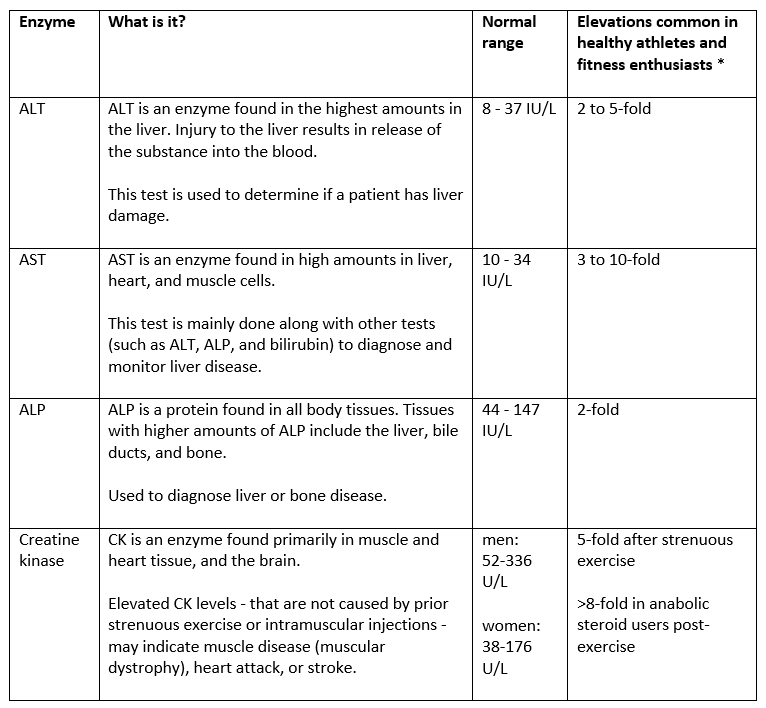
FOLLOW-UP AND IMAGING STUDIES
A repeat set of liver chemistries should be obtained after six months. If the patient’s presentation changes or the physician has concern for an evolving process, shorter intervals can be used. If abnormalities persist at the six-month follow-up visit, ultra-sonography of the liver is recommended. Computed tomography of the abdomen also is used in this setting, although clinical trials have not demonstrated an advantage of this more expensive modality.
Steatohepatitis (or nonalcoholic fatty liver disease) often is discovered by imaging. This condition may be the most frequent cause of mild liver chemistry elevations and is especially common in patients who are obese, and those who have diabetes or hyperlipidemia. One study12 of patients referred to a hospital-based gastroenterology practice found that in 83 percent of patients with elevated transaminase levels whose serum evaluation was otherwise negative, liver biopsy revealed steatosis or steatohepatitis.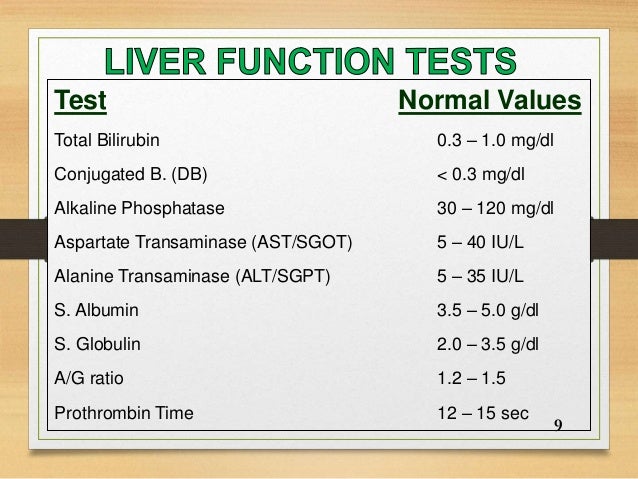 In 10 percent of the patients, however, liver biopsy was normal—a reminder that, at times, mildly elevated transaminase levels do not represent any underlying pathology. Excellent reviews of the management of nonalcoholic fatty liver disease have been published.13,14
In 10 percent of the patients, however, liver biopsy was normal—a reminder that, at times, mildly elevated transaminase levels do not represent any underlying pathology. Excellent reviews of the management of nonalcoholic fatty liver disease have been published.13,14
If the diagnosis is not apparent from the ultrasound examination, further testing is suggested for alpha1-antitrypsin deficiency (alpha1-antitrypsin levels), Wilson’s disease (serum ceruloplasmin), celiac disease (antigliadin and anti-endomysial antibody), and autoimmune hepatitis (antinuclear antibody, anti–smooth-muscle antibody), as well as for nonhepatic causes of transaminase elevation. According to the AGA, the decision to perform a liver biopsy needs to be made on an individual basis, taking into consideration the patient’s age, lifestyle, liver chemistry abnormalities, desire for prognostic information, and associated comorbid conditions.1 Only with chronic mild transaminase elevations would an asymptomatic patient be considered a possible candidate for biopsy.
what are the norms and what does the deviation mean?
Contents
- 1 Normal ALT and AST values in women: how to evaluate your liver
- 1.1 ALT and AST – what are they?
- 1.2 Blood test for ALT and AST
- 1.3 Norm of ALT and AST in women
- 1.4 Deviation of ALT and AST from the norm
- 1.5 Causes of increased levels of ALT and AST in women
- 1.6 Pain treatments that cause elevated levels of ALT and AST in women
- 1.6.1 Hepatitis
- 1.6.2 Cirrhosis of the liver
- 1.6.3 Obesity
- 1.6.4 Other diseases
- 1.7 Symptoms of elevated ALT and AST in women
- 1.8 Diagnosis of elevated ALT and AST
- 1.9 What to do if ALT is elevated and AST
- 1.10 Treatment of Elevated ALT and AST
- 1.11 Nutrition for Elevated ALT and AST
- 1.11.1 Introduction
- 1.
 11.2 What to Eat
11.2 What to Eat - 1.11.3 What to Do avoid
- 1.11.4 Cooking tips
- 1.11.5 Conclusion
- 1.12 Prevention of elevated ALT and AST
- 1.13 Consequences of elevated ALT and AST
- 1.14 Comparison with elevated blood levels of other indicators
- 1.15 Analysis ALT and AST for hepatitis
- 1.15.1 Alanine aminotransferase and Aspartate aminotransferase
- 1.15.2 How to prepare for an ALT and AST test
- 1.15.3 What the test results mean
- 1.16 Effects of ALT and AST on pregnancy
- 1.17 When to see a doctor if ALT and AST levels are elevated
- 1.18 Related videos:
- 1.19 Q&A:
- 9000 5
- 1.19.0.1 What is Alt and Ast and why are these indicators needed in analyzes in women?
- 1.19.0.2 What are the normal levels of Alt and Ast in women?
- 1.19.0.3 What can cause an increase in Alt in women?
- 1.19.0.4 What causes an increase in the Ast level in women?
- 1.
 19.0.5 What does low Alt mean in women?
19.0.5 What does low Alt mean in women? - 1.19.0.6 What can it mean if the level of Alt and Ast is simultaneously elevated in women?
- 1.19.0.7 Can a low Ast level in women indicate the absence of liver problems?
- 1.19.0.8 How long do elevated levels of Alt and Ast persist in women after drinking alcohol?
Find out which ALT and AST values are normal for women. Useful information about the functions of these indicators and the causes of deviations from the norm.
Alt and Ast are enzymes that are responsible for the functioning of the liver. If their blood levels are elevated, this may indicate a liver problem. A blood test for alt and ast is usually ordered in case of suspected liver disease, but what does a deviation in the level of these enzymes mean in women?
ALT and AST blood levels in women depend on many factors, including age, sex, disease, and medication. But in general, the alt level in women should not exceed 31 units/l, and the ast level should not exceed 34 units/l.
If you have been tested for alt and ast and your blood levels of these enzymes are elevated, be sure to discuss the results with your doctor. He will be able to assess your ALT and AST levels in the context of your health and determine if additional testing or treatment is needed.
ALT and AST – what is it?
Alanine aminotransferase (ALT) and aspartate aminotransferase (AST) are enzymes found inside liver cells. If liver cells are damaged or destroyed, these enzymes enter the bloodstream. Therefore, an increase in the level of ALT and AST in the blood may indicate the presence of problems with the liver or other organs.
ALT and AST are often used together in the diagnosis of liver diseases such as hepatitis and cirrhosis. These enzymes can also be elevated in myocardial infarction, rheumatic diseases, and other problems.
ALT and AST blood test
ALT (alianine aminotransferase) and AST (aspartate aminotransferase) blood test is one of the most common methods for diagnosing diseases of the liver and heart. Both are enzymes that are normally found inside the cells of the liver and heart, but if these organs become damaged or inflamed, ALT and AST are released from the cells into the blood, causing their blood levels to rise.
Both are enzymes that are normally found inside the cells of the liver and heart, but if these organs become damaged or inflamed, ALT and AST are released from the cells into the blood, causing their blood levels to rise.
ALT is routinely screened to diagnose liver diseases such as hepatitis, cirrhosis, and liver cancer. ALT levels can also be elevated with certain medications, jaundice, gallbladder disease, and inflammatory diseases of the biliary tract.
Elevated levels of ALT and AST in the blood may indicate a specific disease, but these indicators cannot indicate a specific condition. To detect the disease, additional research and examinations are necessary.
In general, elevated levels of ALT and AST usually indicate damage to some organs in the body. If you are found to have elevated levels of ALT or AST, you should undergo further tests to find out which organs are damaged and begin treatment under the guidance of a qualified physician.
ALT and AST norm in women
Alanine aminotransferase (ALT) and aspartate aminotransferase (AST) are indicators of liver function. Normal blood levels of these enzymes may vary depending on the methodology of the laboratory, as well as the age, sex, and weight of the patient. However, on average, in women, ALT and AST have the following norms:
Normal blood levels of these enzymes may vary depending on the methodology of the laboratory, as well as the age, sex, and weight of the patient. However, on average, in women, ALT and AST have the following norms:
- ALT: up to 34 units/l;
- AST: up to 31 units/l.
If a woman’s ALT and AST levels are higher than normal, this may indicate liver problems such as inflammation, fatty degeneration, or cirrhosis. However, another underlying cause may also be present, such as alcohol or drug poisoning, drug injection, or heart or muscle disease.
If you have been prescribed ALT and AST tests and find that these levels are abnormal, you should consult your doctor to determine the cause and prescribe the appropriate treatment.
ALT and AST abnormal
Alanine aminotransferase (ALT) and aspartate aminotransferase (AST) are enzymes that help the body make proteins. Normal levels of ALT and AST in women can vary, but are usually in the range of 7-56 units/L for ALT and 10-40 units/L for AST.
Abnormal levels of ALT and AST may indicate the presence of liver disease such as hepatitis or cirrhosis. If the level remains elevated for a long time, it can lead to serious complications, including liver failure or liver cancer.
ALT and AST levels may also be elevated in other conditions such as myocardial infarction, pneumonia, or myopathies. This can help diagnose these conditions and track their treatment.
If the levels of ALT and AST strongly deviate from the norm, it is recommended to consult a doctor for additional examination and determination of the cause of such deviation. Early detection and treatment of diseases that can lead to elevated levels of ALT and AST can help maintain health and prevent serious complications.
Causes of increased levels of ALT and AST in women
AST (aspartate aminotransferase) and ALT (alanine aminotransferase) are enzymes that are involved in the process of amino acid metabolism. They are found in the cells of the liver, heart muscle, kidneys and other tissues of the body. If the level of ALT and AST is elevated in a woman, this may indicate the presence of the following reasons:
If the level of ALT and AST is elevated in a woman, this may indicate the presence of the following reasons:
- Liver diseases: elevated levels of ALT and AST may indicate the presence of hepatitis, liver cirrhosis, fatty degeneration and other pathological changes. At the same time, ALT levels may rise earlier than AST.
- Taking medications: Many medications can increase blood levels of ALT and AST. This is especially true of hepatotoxic drugs that have a negative effect on the liver.
- Alcoholic liver disease: The presence of an alcoholic mixture may lead to elevated levels of ALT and AST.
- Myocarditis, hypoxia of the heart muscle: when the heart muscle is affected, AST levels can rise much faster than ALT.
- Non-specific elevation: ALT and AST levels may be elevated with various infectious diseases, trauma and surgery.
In any case, if the level of ALT and AST in a woman is elevated, this requires a mandatory examination and identification of the cause in order to prescribe an effective treatment.
Diseases that cause elevated levels of ALT and AST in women
Hepatitis
Elevated levels of ALT and AST may be associated with hepatitis, an inflammation of the liver that can be caused by viruses, alcohol, drugs, and other factors. In hepatitis, ALT and AST are higher than normal due to damage to liver cells and the release of enzymes into the blood.
Cirrhosis of the liver
Cirrhosis of the liver is characterized by the gradual accumulation of damage to the liver cells, which can cause an increase in the level of ALT and AST. With cirrhosis of the liver, the function of the organ is impaired, which can lead to serious consequences.
Obesity
Obesity can be one of the causes of elevated levels of ALT and AST. Fat accumulates in the liver, which can cause it to malfunction and release enzymes into the blood.
Other diseases
Elevated levels of ALT and AST may also be associated with rarer diseases such as myopathy, muscle wasting, thrombosis, myocardial infarction and others. You need to see a doctor for an accurate diagnosis and treatment.
You need to see a doctor for an accurate diagnosis and treatment.
Symptoms of elevated ALT and AST levels in women
ALT (alanine aminotransferase) and AST (aspartate aminotransferase) are enzymes that are found inside the cells of the liver and other organs. Elevated levels of ALT and AST in the blood can indicate problems with the liver, heart, muscles, and other organs.
In women, elevated levels of ALT and AST may present with the following symptoms:0008
If If you notice any of these symptoms, you should see a doctor for diagnosis and treatment. He may order blood tests for ALT and AST levels, as well as other types of tests to identify possible problems with the body.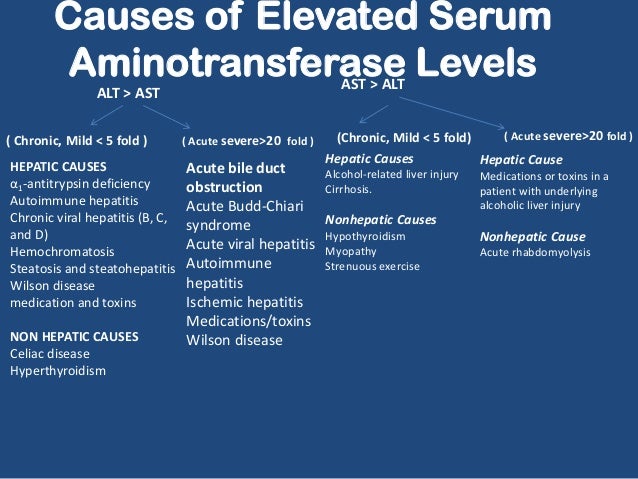
Do not ignore the symptoms of elevated levels of ALT and AST, as these enzymes can indicate serious diseases that require competent medical attention.
Diagnosis of elevated levels of ALT and AST
A special blood test is performed to determine the level of hormones ALT and AST. This test can help diagnose various diseases of the liver, heart, and muscles.
ALT and AST levels may be elevated in the presence of viral hepatitis, alcoholic or toxic hepatitis, liver cirrhosis, infectious mononucleosis, heart and muscle disease. In some cases, an increase in hormone levels may be due to medications taken or tissue damage resulting from an injury.
If the ALT and AST levels are above normal, further investigations are needed to determine the cause of the deviation. Do not panic in advance, because elevated hormone levels do not always indicate a serious illness.
It is important to understand that self-monitoring of ALT and AST levels at home is not sufficient to establish a diagnosis. To do this, you should consult a doctor and perform the recommended tests.
To do this, you should consult a doctor and perform the recommended tests.
What to do with elevated levels of ALT and AST
If you have been diagnosed with elevated levels of ALT and AST in the blood, do not panic, but do not ignore this fact either. First you need to determine the reason for such a deviation. Usually, elevated levels of ALT and AST indicate complications in the liver.
If elevated levels of ALT and AST are caused by a disease or infection, then the doctor may prescribe appropriate treatment, which is aimed at eliminating the reasons for the increase in these levels.
However, sometimes elevated levels of ALT and AST may indicate the presence of chronic diseases of the liver or other organs. In this case, it is necessary to undergo an examination to determine the causes of this condition and prescribe a suitable treatment.
To lower your ALT and AST levels, you need to follow a proper diet, stop bad habits, take the right medications, and have regular medical checkups.
In any case, ALT and AST levels should be monitored regularly. If you find deviations from the norm, you should consult a doctor in a timely manner and undergo an additional examination to find out the causes and prevent possible complications.
Treatment of elevated ALT and AST
As markers of liver damage, ALT and AST are important indicators of liver disease. If ALT and AST levels are high, treatment depends on the underlying cause of the condition.
If elevated levels of ALT and AST are due to alcoholic or viral hepatitis, then the main treatment is the treatment of the underlying disease. In cases of liver failure, increased protein intake and dietary elasticity may be prescribed.
If elevated levels of ALT and AST are associated with medication or supplements, then these drugs should be discontinued. You may have to replace them with safer alternatives.
For people with elevated ALT and AST levels, it is imperative to control alcohol consumption and the abuse of fatty, rich foods.
Based on the above, you need to understand that elevated levels of ALT and AST require careful consideration and analysis of the causes. Only then can you find the appropriate treatment and make the necessary adjustments in your lifestyle and diet.
Nutrition with elevated ALT and AST levels
Introduction
Women with elevated ALT and AST levels should pay attention to their diet. Diet can have a big impact on the levels of these enzymes in the blood, so it is recommended to follow certain rules when compiling your daily menu.
What to eat
When ALT and AST levels are elevated, a healthy diet is given special attention. Women should eat more fresh fruits and vegetables, as well as protein foods such as fish, chicken, eggs, and cottage cheese. It is also recommended to drink plenty of fluids, including clean water.
What to avoid
Women should limit their intake of fatty and fried foods, as well as sweets and alcohol, to avoid elevated ALT and AST levels. In addition, it is recommended to avoid too much coffee and strong tea.
In addition, it is recommended to avoid too much coffee and strong tea.
Cooking Tips
One way to preserve the health benefits of food is to prepare it properly. Women should prefer steamed or grilled dishes. Also, if possible, it is necessary to exclude frying in oil and give preference to cold appetizers and salads.
Conclusion
By following simple healthy dietary guidelines, women can lower their blood levels of ALT and AST. Regular consumption of fresh fruits and vegetables, protein foods, limiting fatty, fried and sugary foods, and proper cooking will help maintain a healthy liver and improve overall body health.
Preventing elevated ALT and AST levels
Maintaining a healthy liver and preventing elevated ALT and AST levels in women requires a healthy lifestyle:
- Avoid alcohol and nicotine;
- Watch your diet and avoid fatty, fried and salty foods;
- Maintain a healthy weight and avoid excess weight;
- Exercise regularly;
- Avoid stress and nervous overload;
- Monitor the level of hormones in the body, especially when taking hormonal drugs.

It is also recommended to undergo regular medical examinations and seek medical attention at the first symptoms of liver disease: pain in the right hypochondrium, nausea, vomiting, jaundice, loss of appetite and drowsiness.
If the level of ALT and AST in the blood of a woman is elevated, then it is necessary to consult a doctor for additional examination and determination of the cause of the deviation.
Sample diet to prevent elevated ALT and ASTV Time Meal
| 8:00 | Breakfast: oatmeal with water, apple, green tea |
| 11: 00 | Snack: fruit yogurt, nuts |
| 2:00 pm | Lunch: grilled chicken breast, steamed vegetables, slice of rye bread, water |
| 20:00 | Dinner: steamed fish, vegetable salad, slice of rye bread, water |
ALT and AST levels
Elevated levels of ALT and AST usually indicate liver dysfunction.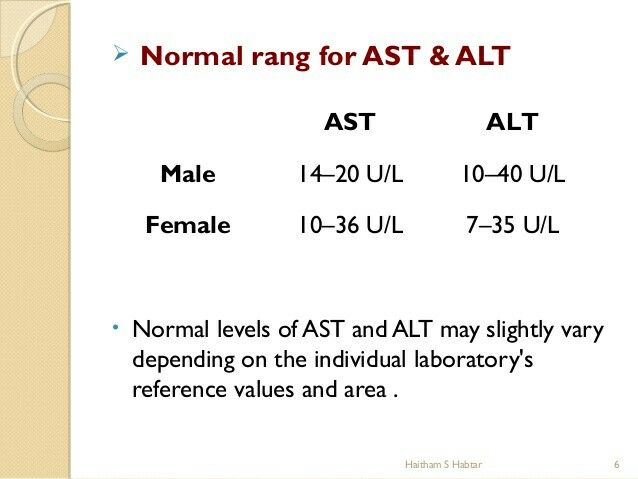 Such violations can be caused by various reasons: from alcohol or drug intoxication to viral infections or cancer.
Such violations can be caused by various reasons: from alcohol or drug intoxication to viral infections or cancer.
One of the first signs of elevated levels of ALT and AST are yellowing eyes and skin, which indicate a violation of the outflow of bile. Other signs may include pain in the right side, bloating, nausea, vomiting, and general weakness.
These signs should not be ignored, as elevated levels of ALT and AST can lead to serious consequences. For example, it can cause cirrhosis of the liver, which in turn can lead to liver cancer and other dangerous diseases. Therefore, if suspicious symptoms appear, you should consult a doctor and undergo an appropriate examination.
- Suspected or developing acute hepatitis
- Confirmed chronic hepatitis
- Suspected gallbladder disease
- May be caused by certain drugs or high alcohol intake
If found elevated high levels of ALT and AST, measures must be taken to eliminate the cause of its occurrence.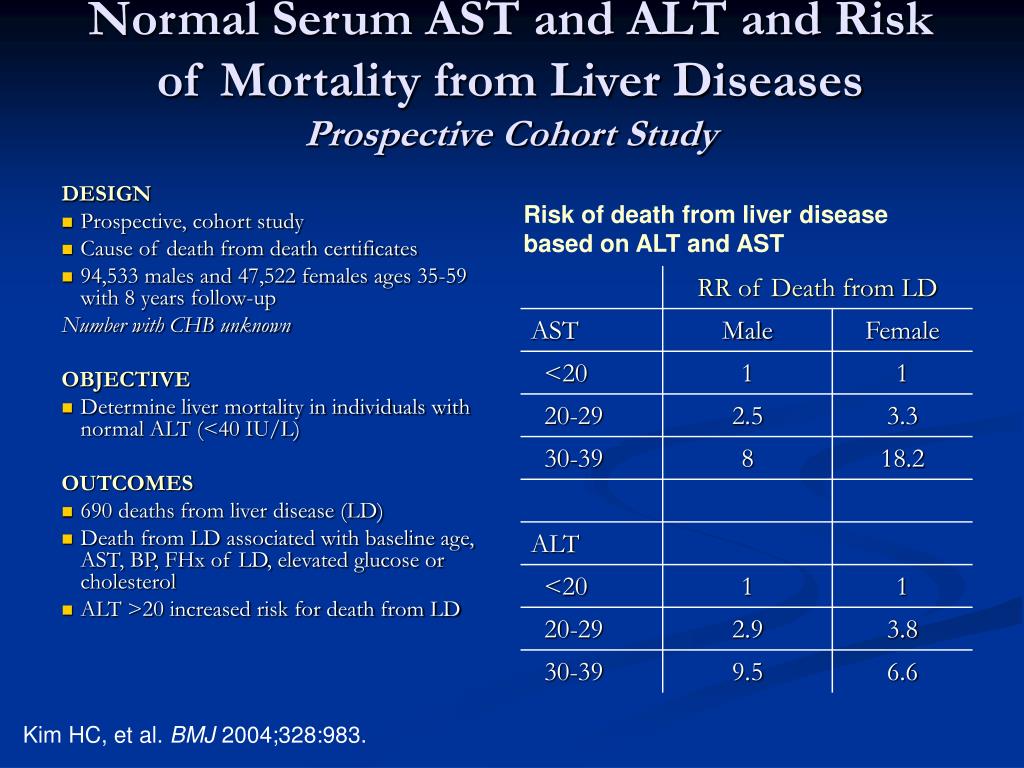 For this, special medications, diet, avoidance of alcohol and other suitable measures can be prescribed.
For this, special medications, diet, avoidance of alcohol and other suitable measures can be prescribed.
Comparison with elevated levels of other blood parameters
The presence of elevated levels of alanine aminotransferase (Alt) and aspartate aminotransferase (AST) can be caused not only by diseases of the liver, cardiovascular system and muscle tissue, but also by the presence of other indicators in the blood, such as iron, glucose, cholesterol and others.
When comparing the levels of Alt and Ast with other indicators, it is necessary to take into account the possible mechanisms for increasing the levels of these enzymes. For example, an increase in the level of Alt and Ast may be associated with a violation of iron metabolism in the body, which leads to its accumulation in the liver and intensive destruction of liver cells.
However, in the presence of elevated levels of Alt and Ast in combination with other indicators, it is necessary to conduct an additional examination to determine the cause of the increase and further treatment.
- Elevated blood glucose may indicate diabetes.
- Elevated cholesterol levels may be associated with impaired lipid metabolism in the body.
- Elevated iron levels may indicate the presence of hemochromatosis.
ALT and AST hepatitis test
Alanine aminotransferase and Aspartate aminotransferase
ALT and AST are enzymes that are found inside liver cells. They are involved in the metabolism of amino acids and help the body get energy from food. High levels of ALT and AST can indicate liver problems, which is why they are usually included in a standard CBC.
One of the most common blood tests for ALT and AST levels is a hepatitis test. Hepatitis is an inflammatory disease of the liver that can be caused by infection, alcohol, or toxins. ALT and AST may be elevated in viral hepatitis, and their rise may reflect the degree of liver damage.
How to prepare for an ALT and AST test
To prepare for an ALT and AST test, you must give blood samples. No other special preparatory measures are required. However, alcohol consumption should be limited prior to testing, as it can increase blood levels of ALT and AST.
No other special preparatory measures are required. However, alcohol consumption should be limited prior to testing, as it can increase blood levels of ALT and AST.
What the test results mean
The normal range for ALT and AST blood levels may vary depending on the laboratory that performs the test. Generally, ALT and AST levels should not exceed 30 to 40 units per liter (U/L) in women. If the level of ALT and AST is elevated, then this may indicate a toxic or infectious liver lesion.
If the results of the analysis show high levels of ALT and AST, then it is necessary to consult with your doctor to identify the possible cause of the elevated ALT and AST levels and begin treatment.
The effect of ALT and AST on pregnancy
ALT and AST are indicators that can be measured in the blood of a pregnant woman at different stages of pregnancy. They play an important role in assessing the health of the liver, but can also indicate problems with the heart and muscles.
Studies show that elevated levels of ALT and AST in the blood of a pregnant woman can indicate the presence of infection, hepatitis, many other diseases, and also negatively affect the development of the child.
Although elevated levels of ALT and AST alone are not dangerous for pregnancy, if the levels of both are elevated, action must be taken. In this case, the woman should consult a doctor and undergo additional examinations.
In addition, maintaining a healthy lifestyle and proper diet can help reduce the risk of elevated ALT and AST levels. Pregnant women need to pay special attention to their health and monitor the level of these indicators in the blood in order to ensure the health of their child and themselves in general.
When to see a doctor if ALT and AST levels are elevated
If a woman’s blood levels of alanine aminotransferase (ALT) and aspartate aminotransferase (AST) are elevated, it can be a symptom of various diseases of the liver, cardiovascular system and other organs.
If a woman notices symptoms such as fatigue, nausea, jaundice, right upper quadrant tenderness, she should seek immediate medical attention.
It is also recommended that women undergo regular medical examinations in order to identify possible problems of the disease at an early stage.
To diagnose the level of ALT and AST, it is necessary to donate blood for biochemical analysis, which can determine the presence of pathological changes.
If ALT and AST levels are elevated, the doctor may order additional tests to determine the cause of the abnormality and prescribe appropriate treatment.
Video on the topic:
Question-answer:
What are Alt and Ast and why are these indicators needed in the analyzes of women?
Alt (alanine aminotransferase) and Ast (aspartate aminotransferase) are enzymes that are found in liver cells and are involved in amino acid metabolism. Their blood levels help diagnose liver disease and assess liver function. When deviating from the norm, Alt and Ast can indicate various pathologies that need to be identified and treated.
Their blood levels help diagnose liver disease and assess liver function. When deviating from the norm, Alt and Ast can indicate various pathologies that need to be identified and treated.
What are the normal levels of Alt and Ast in women?
Alt norm in women is 10-40 U/l, and Ast norm is 10-30 U/l. However, these values may differ depending on the laboratory that performs the analysis. Therefore, when studying the results, it is necessary to be guided by the standards specified in the laboratory where the analyzes were carried out.
What can cause an increase in Alt in women?
An increase in the level of Alt in the blood of women can be caused by diseases such as viral hepatitis, cirrhosis of the liver, fatty liver, as well as the use of alcohol or toxic drugs. Also, an increase in Alt levels may be associated with muscle damage, along with damage to liver cells.
What causes an increase in the Asth level in women?
An increase in the level of Ast in the blood in women can be caused by liver pathologies (cirrhosis, hepatitis), myocardial infarction, encephalopathy, jaundice. Also, an increase in the level of Ast can be observed in oncological diseases, alcoholism and the use of toxic drugs.
Also, an increase in the level of Ast can be observed in oncological diseases, alcoholism and the use of toxic drugs.
What does low Alt mean in women?
Decrease in the level of Alt in the blood is not a pathology and in itself does not cause any symptoms. However, if the Alt level is reduced, but the Ast level remains normal, then this may indicate a violation of liver function and require further examination and diagnosis.
What can it mean if the level of Alt and Ast is simultaneously elevated in women?
Simultaneous elevation of Alt and Ast may indicate various liver diseases such as hepatitis, cirrhosis or cancer. Also, an increase in the level of Alt and Ast may be associated with dysfunction of other organs, such as skin, muscles and pancreas. The final diagnosis can only be made after a comprehensive examination and exclusion of other pathologies.
Can a low Ast level in women indicate the absence of problems with the liver?
No, a low blood Asth level is not a sufficient criterion for assessing the health of the liver.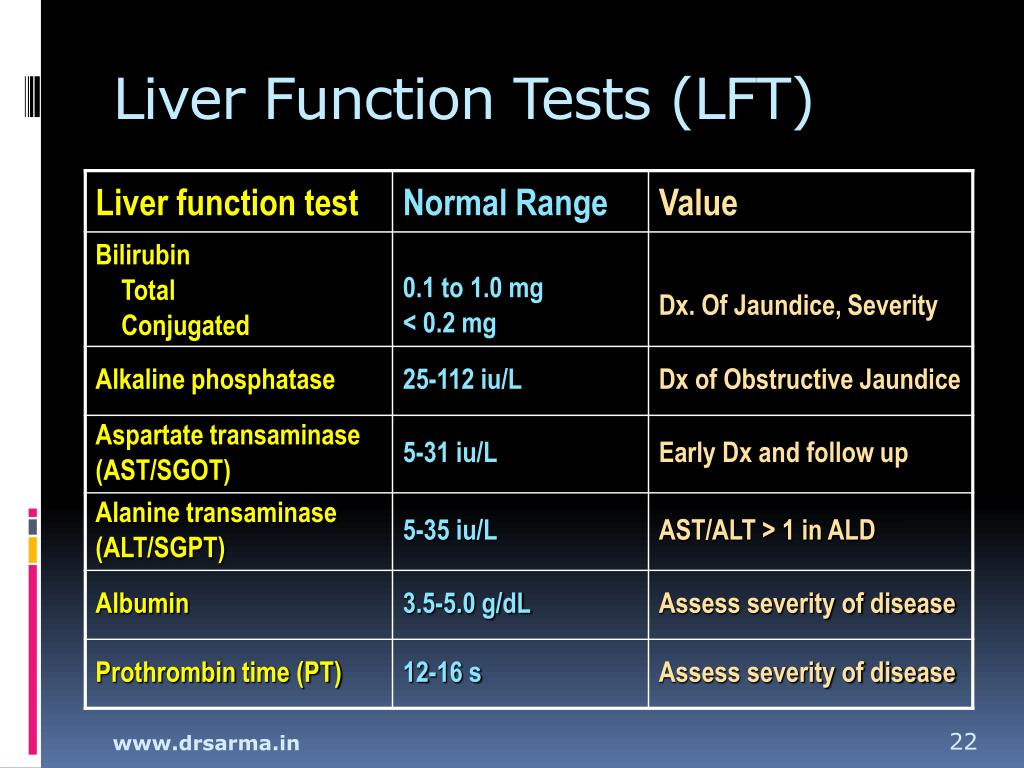 For a complete diagnosis, it is necessary to conduct a comprehensive examination and analysis of other biochemical blood parameters that will help identify possible pathologies.
For a complete diagnosis, it is necessary to conduct a comprehensive examination and analysis of other biochemical blood parameters that will help identify possible pathologies.
How long do elevated Alt and Ast levels persist in women after drinking alcohol?
Increased levels of Alt and Ast in the blood of women may persist up to 4-5 days after drinking alcohol. The more often and more alcohol is consumed, the longer elevated levels of these indicators persist. Stopping alcohol consumption helps bring Alt and Ast levels back to normal levels. However, if elevated levels of Alt and Ast do not decrease for a long time, additional diagnostics and examination are necessary.
Aspartate aminotransferase (AST, AST): norm and interpretation
Aspartate aminotransferase (AST, AST ) is an enzyme involved in biochemical processes inside cells. AST accelerates the transfer of amino groups from aspartate (and ALT from alanine, respectively) in the Krebs cycle, which is a key step in the respiration process for all cells. Note that AST performs its functions together with vitamin B 6 , although AST is less sensitive to a decrease in the content of B 6 in the body than ALT . By the way, this is the reason why in patients with alcoholic liver disease the concentration of ALT in the blood decreases more significantly than AST , which contributes to an increase in the ratio of AST / ALT , because the systematic use of alcohol significantly reduces the content of vitamin B 6 in the blood.
Note that AST performs its functions together with vitamin B 6 , although AST is less sensitive to a decrease in the content of B 6 in the body than ALT . By the way, this is the reason why in patients with alcoholic liver disease the concentration of ALT in the blood decreases more significantly than AST , which contributes to an increase in the ratio of AST / ALT , because the systematic use of alcohol significantly reduces the content of vitamin B 6 in the blood.
Both aminotransferases are concentrated in liver tissues, however AST is also present in the heart, skeletal muscle, kidney, brain, and erythrocytes. In the liver ALT is concentrated exclusively in the cellular cytoplasm, while AST is found in the cytosol and mitochondria. The circulating half-life is about 47 hours for ALT and about 17 hours for AST .
To assess the change in level AST use the classification:
- Soft change – an increase of less than 5 times the maximum allowable limit,
- Moderate change – 5 to 10 times normal,
- Marked change – more than 10 times normal.

However, given the blurring of the boundary between mild and moderate changes, they are considered one group.
The norm for children and adolescents is slightly different from the norm for adults:
| Age | AST content, U / l |
|---|---|
| up to 97.0 | |
| 5 days–6 months | up to 77.0 |
| 6–12 months | up to 82.0 9 0310 |
| 1-3 years | up to 48.0 |
| 3-6 years | up to 36.0 |
| 6-12 years | up to 47.0 |
| up to 25.0 | |
| 12–17 years old (men) | up to 29.0 |
Normally, only a small part of it is in the blood. When tissues rich in this enzyme are damaged, it enters the bloodstream, which is detected by laboratory methods. Abrupt changes in the content of aspartate aminotransferase occur with damage to the heart muscle – myocardium (for example, with myocardial infarction). The concentration of this enzyme in the blood of 93−98% of patients with myocardial infarction increased. In this case, AST increases in serum after 6-8 hours, it reaches its maximum concentration after 24-36 hours and decreases to a normal level by the 5-6th day. An increase in the area of the heart muscle affected by a heart attack (repeated heart attack) leads to the appearance of a second cycle of increasing the concentration of aspartate aminotransferase . Sometimes the activity of AST increases even before the appearance of electrocardiographic signs of myocardial infarction, and the absence of a decrease in its level after the 3-4th day of the disease is considered an unfavorable sign.
The concentration of this enzyme in the blood of 93−98% of patients with myocardial infarction increased. In this case, AST increases in serum after 6-8 hours, it reaches its maximum concentration after 24-36 hours and decreases to a normal level by the 5-6th day. An increase in the area of the heart muscle affected by a heart attack (repeated heart attack) leads to the appearance of a second cycle of increasing the concentration of aspartate aminotransferase . Sometimes the activity of AST increases even before the appearance of electrocardiographic signs of myocardial infarction, and the absence of a decrease in its level after the 3-4th day of the disease is considered an unfavorable sign.
Patients with a marked increase in aminotransferase levels (greater than 10-fold) are usually diagnosed with acute liver disease. However, data for a number of patients with acute liver injury caused by viral hepatitis suggest that the most sensitive and specific threshold level of aminotransferases for detecting acute lesions lies within the moderate range (5 to 10 times normal). In cases of acute viral hepatitis, the level of AST typically peaks before jaundice develops and gradually decreases thereafter; in parallel, the level of bilirubin in the blood serum increases. However, jaundice occurs in about 70% of cases of acute hepatitis A, 33% -50% of cases of acute hepatitis B and 20% -33% of cases of acute hepatitis C. The entire spectrum of viral hepatitis (A, B, C, D and E) can be responsible for the marked increase in level AST and ALT , although the increase associated with hepatitis C tends to be more modest than that associated with hepatitis A or B.
In cases of acute viral hepatitis, the level of AST typically peaks before jaundice develops and gradually decreases thereafter; in parallel, the level of bilirubin in the blood serum increases. However, jaundice occurs in about 70% of cases of acute hepatitis A, 33% -50% of cases of acute hepatitis B and 20% -33% of cases of acute hepatitis C. The entire spectrum of viral hepatitis (A, B, C, D and E) can be responsible for the marked increase in level AST and ALT , although the increase associated with hepatitis C tends to be more modest than that associated with hepatitis A or B.
If an increased level of AST and ALT is detected, and the presence of risk factors ( for example, travel to an area affected by hepatitis infections) or clinical symptoms, check for hepatitis A and B IgM antibodies, hepatitis B surface antigens, and hepatitis C antibodies, and, if necessary, use polymerase chain reaction (PCR) methods for these viruses .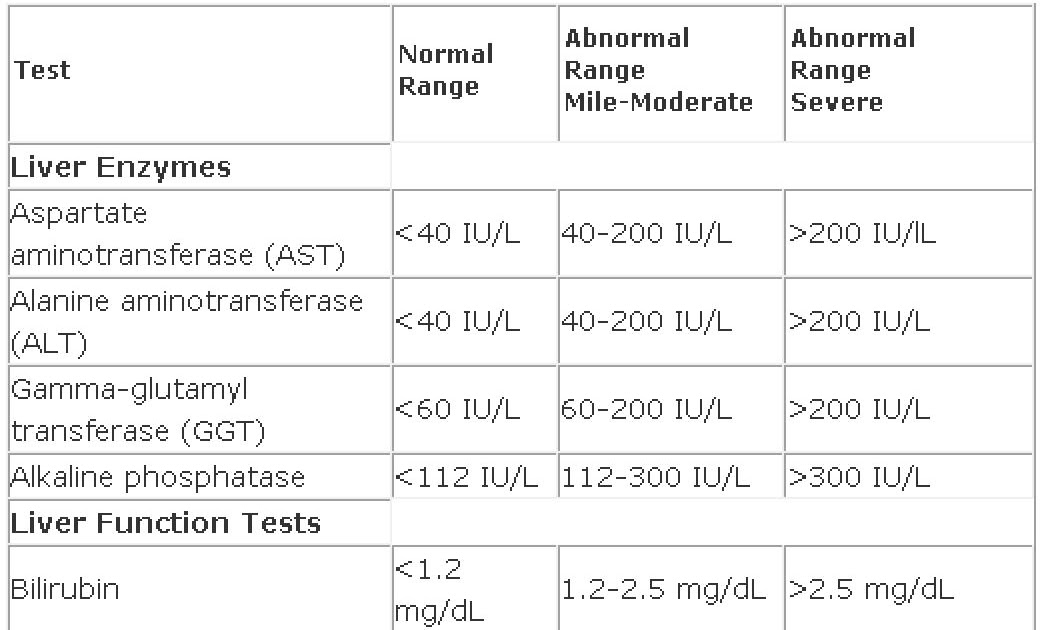
In addition, the increase in the level of AST is affected by viruses other than hepatitis – for example, Epstein-Barr virus or cytomegalovirus, as well as autoimmune, extrahepatic and congenital causes. Autoimmune hepatitis can cause both moderate and marked increases in AST and ALT levels. Finally, 25% of patients with AST levels 10 times normal may have acute biliary obstruction, as evidenced by peak aminotransferase levels (more than 50 times normal for 1-2% of patients). In this case, the final diagnosis is confirmed by ultrasound and specific pain in the patient.
Minimal or slight increase in the level of aminotransferases is the most common change in the biochemical analysis of blood. If such an increase is detected in a patient, it is recommended to re-analyze to rule out laboratory error and verify the stability of the increase in the level of AST and / or ALT . For example, chronic hepatitis C infection is characterized by aminotransferase levels fluctuating near the upper limit of normal. For patients taking drugs that are toxic to the liver and for the group of patients who consume alcohol, confirmatory control of aminotransferase levels can be carried out only after cessation of alcohol or drug use.
For patients taking drugs that are toxic to the liver and for the group of patients who consume alcohol, confirmatory control of aminotransferase levels can be carried out only after cessation of alcohol or drug use.
Non-alcoholic fatty liver disease (NAFLD) is the most common cause of minor changes in serum levels of AST and ALT in developed countries. As in chronic viral hepatitis, the AST/ALT ratio exceeds 1, which is observed in 61% of patients with an advanced form of liver tissue fibrosis and in 24% of patients with no or initial fibrosis. Suspicion of non-alcoholic fatty liver disease is increased in the presence of risk factors, which include obesity, diabetes, hyperlipemia, and hypertension, although the disease may occur in patients without these factors.
With angina, the content of AST , as a rule, remains within the normal range, sometimes it increases slightly in the first 24 hours after an attack.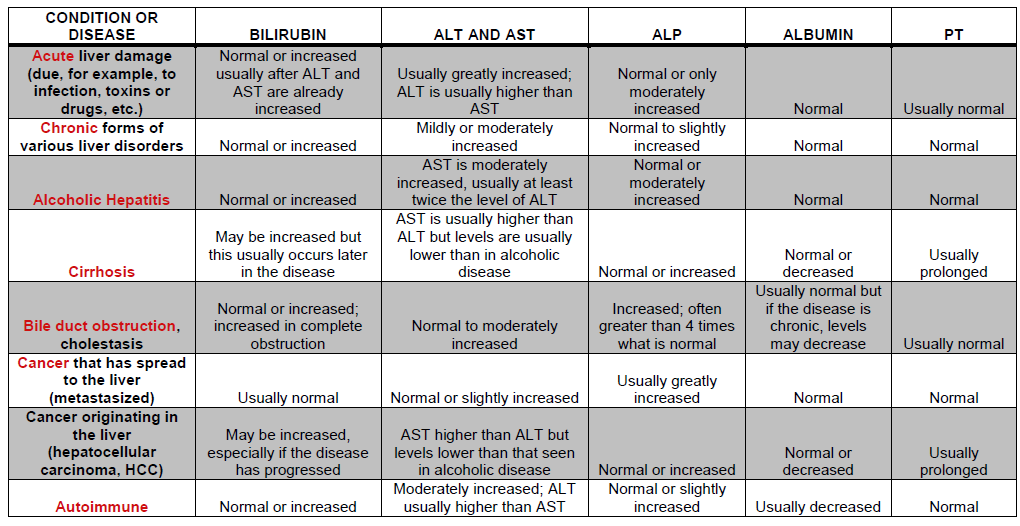 A moderate increase in the content of aspartate aminotransferase is observed in patients with liver metastases and cirrhosis.
A moderate increase in the content of aspartate aminotransferase is observed in patients with liver metastases and cirrhosis.
In practice, the simultaneous determination of the activity of AST and alanine aminotransferase (ALT, ALT) in the blood is widely used, since it carries much more information about the disease and its nature and allows predicting the outcome of the disease. There is a de Ritis coefficient, that is, the ratio AST / ALT , normally equal to 1.33 . In liver diseases, the de Ritis coefficient is below normal, and in heart diseases it is higher.
Similar to ALT , blood levels of AST may indicate a risk of death within the next decade. There may be several mechanisms by which AST and ALT may be associated with an increased risk of death. First, aminotransferases, being markers of serious liver disease, indicate the risk of mortality from liver disease.

 11.2 What to Eat
11.2 What to Eat 19.0.5 What does low Alt mean in women?
19.0.5 What does low Alt mean in women?
